Personal sanitario y salud en Palestina
Información específica sobre daños a infraestructuras, personal, las consecuencias del asedio, el hambre, el impacto de la destrucción del sistema sanitario. Apartado para seguir y estar al día del impacto de la barbarie de Israel en la salud de personas, familias y comunidades de Gaza-Palestina-Líbano.
Gaza. 2020-25. Changes in psychological distress. Deterioro mental: estudio longitudinal. ENG ESP

ENGLISH
This study employs a longitudinal design to follow the mental health of adults in the Gaza Strip across three time points, including baseline data collected before the outbreak of the current war in October 2023, up to January 2025. To our knowledge, it is the first population-based study to track individual-level changes in psychological distress in Gaza over multiple years.Our findings demonstrate a threefold increase in the prevalence of severe distress by 2025 compared to 2020. This temporal perspective adds critical new insight by building on pre-war data to quantify the mental health impact of war, a study design rarely available in Gaza or other war-affected regions.
While our study cannot establish causality, the recent tripling of severe psychological distress evolved from a background of an exceedingly high mental health burden before October 2023. Our findings underscore the relevance of providing long-term psychosocial and mental health services, including strengthening resilience, to prevent long-term consequences for the current and next generations in Gaza and other conflict-affected populations. Future research should examine the long-term mental health trajectories and resilience, including intergenerational impacts.ESPAÑOL
Cambios en el malestar psicológico durante la escalada del conflicto en una cohorte poblacional adulta en la Franja de Gaza (2020-2025): un análisis longitudinalEste estudio emplea un diseño longitudinal para seguir la salud mental de los adultos en la Franja de Gaza en tres momentos, incluyendo datos de referencia recopilados antes del estallido de la guerra actual en octubre de 2023, hasta enero de 2025.Hasta donde sabemos, es el primer estudio poblacional que rastrea los cambios a nivel individual en el malestar psicológico en Gaza a lo largo de varios años.Nuestros hallazgos demuestran un aumento del triple en la prevalencia del malestar severo para 2025 en comparación con 2020.Esta perspectiva temporal aporta una perspectiva crucial al basarse en datos anteriores a la guerra para cuantificar el impacto de la guerra en la salud mental, un diseño de estudio poco común en Gaza u otras regiones afectadas por la guerra. Si bien nuestro estudio no puede establecer causalidad, la reciente triplicación del malestar psicológico grave surgió de un contexto de una carga de salud mental extremadamente alta antes de octubre de 2023.Nuestros hallazgos subrayan la importancia de brindar servicios psicosociales y de salud mental a largo plazo, incluyendo el fortalecimiento de la resiliencia, para prevenir consecuencias a largo plazo para las generaciones actuales y futuras en Gaza y otras poblaciones afectadas por el conflicto.Las investigaciones futuras deberían examinar las trayectorias de salud mental a largo plazo y la resiliencia, incluyendo los impactos intergeneracionales.Gaza. Women Facing Genocide. Mujeres y genocidio

ENGLISH
Gaza, Palestine – Beirut, Lebanon – The Palestinian Association for Human Rights (Witness) has released a detailed report titled "Women Facing Genocide: Health and Care Challenges in Gaza." Based on extensive research, in-depth analysis, and meticulous fieldwork, the report highlights the devastating impact of the ongoing war on women in Gaza. It underscores the war's classification as a crime of genocide against Palestinians, with women being among the most profoundly affected groups.
Gaza women suffering: Alarming statistics
Casualties: Over 10,000 women have lost their lives due to ongoing attacks, with a dramatic rise in the number of widows and displaced individuals. Women and children make up nearly 70% of the victims.
Pregnant Women and Mothers: More than 49,000 pregnant women are enduring dire conditions, including 17,000 at risk of starvation, while 155,000 others face severe challenges in accessing essential medical care.
Hygiene Crisis: Approximately 690,000 women and girls lack access to sanitary pads, heightening the risks of infectious diseases.
Israeli occupation's crimes against women
Direct Targeting: Displaced women are being directly targeted by airstrikes and assaults while seeking refuge.
Arbitrary Detention: Israeli forces have arrested over 142 women, including young girls and infants, under brutal and inhumane conditions.
Women with Disabilities: The number of women with disabilities has increased significantly due to the occupation’s use of internationally prohibited weapons.
Women in Gaza: victims of grave violations
The report highlights that women in Gaza are facing severe violations of international law, with breaches of the 1949 Geneva Convention and the 1977 Additional Protocol I, particularly through the lack of protection and the deliberate targeting of hospitals. They are also being denied basic rights guaranteed by the Universal Declaration of Human Rights and the Convention on the Elimination of All Forms of Discrimination Against Women (CEDAW), including access to healthcare and reproductive rights. The report further asserts that the systematic policies targeting women may constitute a crime of genocide under Article 6 of the Rome Statute, through the imposition of living conditions that lead to destruction and forced sterilization.
Research Efforts to Document Violations
This report is the result of extensive efforts, including daily monitoring of the field situation, analysis of firsthand testimonies, and a review of official data and international human rights reports. Its objective is to reveal the alarming realities of the targeting of Palestinian women—not only through death and destruction but also by obstructing access to healthcare and reproductive services, which constitutes a clear violation of international humanitarian law. The report emphasizes that the targeting of Palestinian women is part of a deliberate, systematic policy aimed at dismantling the Palestinian community.
Urgent Recommendations for Protecting Women in Gaza:
Immediate action to protect women in Gaza, beginning with the deployment of international monitors to ensure their safety and the establishment of secure humanitarian corridors.
International investigations by the International Criminal Court into the systematic crimes committed against women.
Providing medical supplies to support reproductive health and emergency services, as well as launching comprehensive rehabilitation programs for women survivors of the war, addressing both their psychological and social needs.
Global awareness campaign to highlight the suffering of women in Gaza, aiming to rally global solidarity and pressure the occupation authorities to halt the ongoing violations.
ESPAÑOL
Mujeres en Gaza: genocidioGaza, Palestina – Beirut, Líbano – La Asociación Palestina para los Derechos Humanos (Witness) ha publicado un informe detallado titulado "Mujeres que enfrentan el genocidio: Desafíos en materia de salud y atención en Gaza".Basado en una extensa investigación, un análisis profundo y un meticuloso trabajo de campo, el informe destaca el impacto devastador de la guerra en curso sobre las mujeres en Gaza. Subraya la clasificación de la guerra como un crimen de genocidio contra los palestinos, siendo las mujeres uno de los grupos más profundamente afectados.Mujeres de Gaza sufriendo: Estadísticas alarmantesVíctimas: Más de 10.000 mujeres han perdido la vida debido a los continuos ataques, con un drástico aumento en el número de viudas y personas desplazadas. Las mujeres y los niños representan casi el 70% de las víctimas.Mujeres embarazadas y madres: Más de 49.000 mujeres embarazadas padecen condiciones extremas, incluyendo 17.000 en riesgo de inanición, mientras que otras 155.000 enfrentan graves dificultades para acceder a la atención médica esencial.Crisis de higiene: Aproximadamente 690.000 mujeres y niñas carecen de acceso a tampones y compresas, lo que aumenta el riesgo de contraer enfermedades infecciosas.Crímenes de la ocupación israelí contra las mujeresAtaques directos: Las mujeres desplazadas son blanco directo de ataques aéreos y agresiones mientras buscan refugio.Detención arbitraria: Las fuerzas israelíes han arrestado a más de 142 mujeres, incluidas niñas y bebés, en condiciones brutales e inhumanas.Mujeres con discapacidad: El número de mujeres con discapacidad ha aumentado significativamente debido al uso de armas prohibidas internacionalmente por parte de la ocupación.Mujeres en Gaza: víctimas de graves violaciones El informe destaca que las mujeres en Gaza se enfrentan a graves violaciones del derecho internacional, con infracciones de la Convención de Ginebra de 1949 y el Protocolo Adicional I de 1977, en particular debido a la falta de protección y los ataques deliberados contra hospitales. También se les niegan los derechos básicos garantizados por la Declaración Universal de Derechos Humanos y la Convención sobre la Eliminación de Todas las Formas de Discriminación contra la Mujer (CEDAW), incluido el acceso a la atención médica y los derechos reproductivos. El informe afirma además que las políticas sistemáticas dirigidas a las mujeres podrían constituir un delito de genocidio en virtud del Artículo 6 del Estatuto de Roma, al imponerles condiciones de vida que conducen a la destrucción y la esterilización forzada.Investigación para Documentar las ViolacionesEste informe es el resultado de un amplio trabajo, que incluye el monitoreo diario de la situación sobre el terreno, el análisis de testimonios de primera mano y la revisión de datos oficiales e informes internacionales de derechos humanos. Su objetivo es revelar la alarmante realidad de los ataques contra las mujeres palestinas, no solo mediante la muerte y la destrucción, sino también obstruyendo el acceso a la atención médica y los servicios reproductivos, lo que constituye una clara violación del derecho internacional humanitario.El informe enfatiza que los ataques contra las mujeres palestinas forman parte de una política deliberada y sistemática destinada a desmantelar la comunidad palestina.Recomendaciones urgentes para la protección de las mujeres en Gaza:Acciones inmediatas para proteger a las mujeres en Gaza, comenzando con el despliegue de observadores internacionales para garantizar su seguridad y el establecimiento de corredores humanitarios seguros. Investigaciones internacionales de la Corte Penal Internacional sobre los crímenes sistemáticos cometidos contra las mujeres.Proporcionar suministros médicos para apoyar la salud reproductiva y los servicios de emergencia, así como poner en marcha programas integrales de rehabilitación para las mujeres sobrevivientes de la guerra, atendiendo tanto sus necesidades psicológicas como sociales.Campaña mundial de concienciación para visibilizar el sufrimiento de las mujeres en Gaza, con el objetivo de movilizar la solidaridad mundial y presionar a las autoridades de ocupación para que pongan fin a las violaciones en curso.Torturas en Israel (y complicidad del personal sanitario). Torture and health worker complicity. ESP ENG
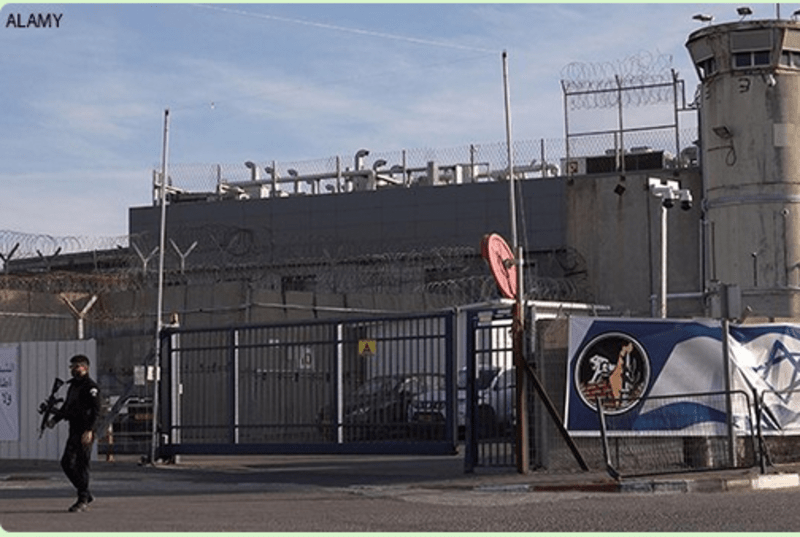
ESPAÑOL
Tortura y complicidad del personal sanitario en centros de detención israelíes.
No hay lugar para el abuso de la medicina como instrumento de represión y violencia estatal. Estas prácticas representan una abominable afrenta a nuestros valores y responsabilidades profesionales y constituyen graves violaciones del derecho fundamental a la vida, la salud y la dignidad de nuestros colegas palestinos. La tortura no solo destruye la vida de sus víctimas, sino que la participación y complicidad del personal sanitario en estos actos socava la integridad de las profesiones sanitarias y de todas las personas e instituciones que la hacen posible. Ante tales violaciones, tenemos la obligación moral y legal no solo de denunciar, sino también de actuar.
ENGLISH
Torture and health worker complicity in Israeli detention sites.
There is no place for the misuse of medicine as an adjunct to state repression and violence. Such practices represent an abhorrent derogation of our professional values and responsibilities and are gross violations of our Palestinian colleagues’ basic right to life, health, and dignity. Torture not only destroys the lives of its victims but health worker participation and complicity in such acts corrodes the integrity of the health professions, and all those individuals and institutions that enable it. In the face of such violations, we have a moral and legal obligation, not only to speak out, but to act.
To know more:
Over 3 million life-years lost in Gaza. Más de 3 millones de años de vida perdidos en Gaza. ENG ESP
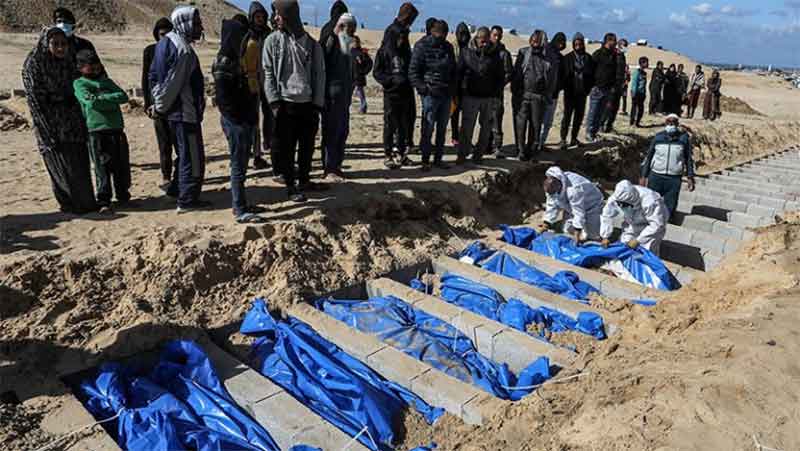
ENGLISH
Over 3 million life-years lost in Gaza
As of July 31, 2025, we estimated a total of 3 082 363 (95% CI 2 962 715–3 206 048) life-years lost in Gaza.
The division of total life-years lost by the count of deceased people (60 199) gives 51·2 years of life lost per death (49·2–53·3).
When calculated by sex, 1 075 984 (1 023 952–1 130 142) female life-years and 2 006 379 (1 938 762–2 075 906) male life-years have been lost.
More than 1 million life-years involving children under the age of 15 years (95% CI 1 027 262–1 112 087) have been lost.
ESPAÑOL
Más de 3 millones de años de vida perdidos en Gaza
Al 31 de julio de 2025, estimamos un total de 3 082 363 (IC del 95%: 2 962 715–3 206 048) años de vida perdidos en Gaza. Al dividir el total de años de vida perdidos entre el número de fallecidos (60 199), se obtiene una pérdida de 51,2 años de vida por cada muerte (49,2–53,3).
Por sexo, se han perdido 1 075 984 (1 023 952–1 130 142) años de vida de mujeres y 2 006 379 (1 938 762–2 075 906) años de vida de hombres.
Se han perdido más de 1 millón de años de vida de niños menores de 15 años (IC del 95% 1 027 262–1 112 087).
West Bank under occupation. Cisjordania bajo la bota israelí. ENG ESP
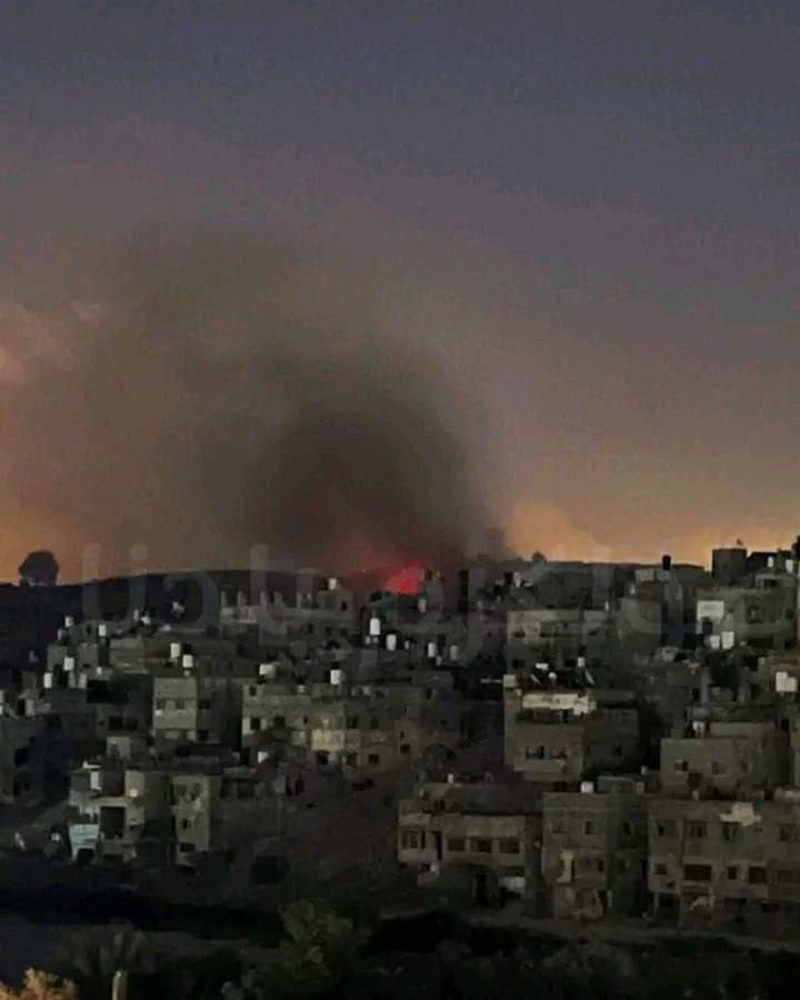
ENGLISH
West Bank under occupation 26 Oct 2025
We are not seeing enough news about what's happening in the West Bank every single hour. I worked on this summary as an example:1- The Israeli occupation forces raided the town of Qasrah, south of Nablus.
2- The Israeli occupation forces raided the town of Deir Abu Mashaal, west of Ramallah.
3- The Israeli occupation forces raided the town of Beit Ommar, north of Hebron.
4- The Israeli occupation forces raided the town of Sureif, north of Hebron.
5- The Israeli occupation forces raided the town of Imatin, east of Qalqilya.
6- The Israeli occupation forces raided homes in the Old City of Nablus.
7- The Israeli occupation forces raided al-Zawyah town in Salfit.
8- The Israeli occupation forces raided people’s homes in al-Jalazon Camp, north of Ramallah, abducting four people — one of them a 13-year-old child.
9- The Israeli occupation forces raided the town of al-Issawiyyah in occupied Jerusalem.
10- A Palestinian was shot by the Israeli occupation forces north of occupied Jerusalem.
11- The Israeli occupation forces raided the city of Al-Bireh.
12- The Israeli occupation forces raided the town of Sebastia, northwest of Nablus.
13- The Israeli occupation forces assault the families of the village of Kobar, north of Ramallah, abducting some, even after “permitting” them to harvest their olives.
14- The Israeli occupation forces raided the town of Arura, northwest of Ramallah.
15- The Israeli occupation forces raided the town of Silwad, northeast of Ramallah.
16- The Israeli occupation forces are bulldozing Palestinian farms in the al-Buaira area, east of Hebron. (Ongoing)
17- The Israeli occupation forces raided the German neighborhood in Jenin.
18- The Israeli occupation police raided the town of al-Ram, north of occupied Jerusalem. (Ongoing)
19- The Israeli occupation forces raided the town of Deir Abu Daeef, east of Jenin.
20- The Israeli occupation forces raided al-Kassarat neighborhood near Qalandia Camp, north of Jerusalem.
21- Israeli settlers opened fire on residents of the town of Sinjil, north of Ramallah.
22- The Israeli occupation forces forced families to shut down their shops while raiding the town of Sebastia, northwest of Nablus.
23- Four Palestinians were wounded by Israeli gunfire in al-Bireh. One of the casualties is in very critical condition.
24- The Israeli occupation forces raided the town of Qifin, north of Tulkarem.
25- The Israeli occupation forces set fire to a house in Nur Shams Camp, east of Tulkarem.
26- The Israeli occupation forces raided the town of Burqin, west of Jenin.
27- The Israeli occupation forces wounded a Palestinian in the town of Turmus Ayya, northeast of Ramallah.
28- (Now) The Israeli occupation forces are raiding the town of Qabatiyah, south of Jenin. Two people were critically wounded.
29- (Now) The Israeli occupation forces are raiding the town of Kafr Malik, east of Ramallah.
30- (Now) The Israeli occupation forces are raiding the town of Silwad, northeast of Ramallah.
31- Israeli settlers have cut down 80 olive trees in the town of Wadi Sa’eer, northeast of Hebron.UN Human Rights in Occupied Palestinian Territory
Ramallah
27 October 2025
Israeli settler attacks surging: displacement and steps to annex intensify in the occupied
West BankOngoing attacks by illegal Israeli settlers, often supported and joined by Israeli security
forces, continue to instil fear, destroy homes and livelihoods, and force Palestinians out of
their lands in the occupied West Bank. These actions advance Israel’s stated policy to
consolidate annexation in clear violation of international law.
Several attacks over the weekend reflect the persistent Palestinian precarity in the face of
Israeli settler violence.
The olive harvest
On 24 October, a video verified by the UN Human Rights office in the Occupied Palestinian
Territory shows an Israeli settler, joined by Israeli security forces , together severely assaulting
a 58 -year-old olive farmer in Nahhalin , Bethlehem.
The Israeli military said the incident is being investigated. However, settlers and Israeli
security forces have so far enjoyed complete impunity for attacks against Palestinians, even
deadly ones.
Attacks against Bedouin communities
Settler violence is escalating far beyond the olive harvest season, making life impossible for
Palestinians in many communities across the occupied West Bank and leaving them with no
genuine choice but to leave their homes.
In another grave incident on Saturday, 25 October, a mob of masked Israeli settlers first
attacked Palestinians picking olives in Mikhmas, then set fire to six Palestinian homes in the
nearby Khallet As Sidra, a Bedouin Palestinian community northeast of occupied East
Jerusalem.
According to monitoring by the UN Human Rights office, the community, like many others in
the West Bank, has been repeatedly attacked by Israeli settlers over the past two years to
force residents to leave and expand illegal outposts in the area.
Recently, all Palestinian women and children relocated from Khillet As Sidra for safety
reasons, and the men stayed to prevent seizure of their homes by settlers. The Saturday
arson reportedly engulfed several of the homes held by the remaining men.During the attack, settlers also injured five Palestinian men and two Israeli women solidarity activists.
As Israel escalates its campaign of forced transfer to clear large swaths of the occupied West
Bank from Palestinian residents, entire Bedouin communities have been displaced over the
past two years.According to the UN Office for Coordination of Humanitarian Affairs
(OCHA) , about 3,200 Palestinians from dozens of Bedouin and herding communities have
been forcibly displaced by settler violence and movement restrictions since 7 October 202 3,
mostly from Area C .
Consolidating annexation
Over the past year , there have been 84 new settler outposts compared to 49 the year before ,
according to data from the Israeli NGO Peace Now. This marks a rapid escalation
compared to the yearly average of eight outposts in the past decade.
In association, settler violence is also surging with 757 attacks recorded in the first half of
2025 alone - 13 per cent higher than the same period last year. Most attacks have been
recorded in Area C , which is increasingly being emptied of Palestinians. However , the UN
Human Rights office has also been increasingly documenting attacks in Area B, indicating
an ever-shrinking space for Palestinians.
The International Court of Justice concluded that the occupation must end, and Israel must
withdraw from all the Occupied Palestinian Territory, both the West Bank and Gaza. This
includes immediately dismantling all settlements and evacuating all settlers.
ENDS
For more information and media requests, please contact:
Mayy El Sheikh – mayy.elsheikh@un.orgHumanitarian Situation Update #335 | West Bank
31 Oct 2025Key Highlights
1/ Three Palestinian men were killed in an exchange of fire with Israeli forces and by an Israeli airstrike in Jenin. The UN Human Rights Office emphasizes that the use of airstrikes in the occupied West Bank is unlawful.
2/ Over the past week, 60 Israeli settler attacks were recorded across the West Bank, more than half in relation to the olive harvest, resulting in the injury of 17 Palestinians and extensive property damage.
3/ The 2025 olive harvest season has so far witnessed the highest level of damage and number of affected communities due to settler attacks since 2020, with 126 attacks recorded in 70 towns and villages and over 4,000 olive trees and saplings vandalized.
4/ Israeli settlers from newly established settlement outposts in the West Bank have increasingly imposed restrictions on Palestinians’ access to their olive groves, including in areas that were previously accessible without ‘prior coordination’ with Israeli authorities.
ESPAÑOL
Cisjordania bajo ocupaciónMosab Abu Toha@MosabAbuTohaNo vemos suficientes noticias sobre lo que sucede en Cisjordania cada hora. Elaboré este resumen como ejemplo:1- Las fuerzas de ocupación israelíes asaltaron la ciudad de Qasrah, al sur de Nablus.2- Las fuerzas de ocupación israelíes asaltaron la ciudad de Deir Abu Mashaal, al oeste de Ramallah.3- Las fuerzas de ocupación israelíes asaltaron la ciudad de Beit Ommar, al norte de Hebrón.4- Las fuerzas de ocupación israelíes asaltaron la ciudad de Sureif, al norte de Hebrón.5- Las fuerzas de ocupación israelíes asaltaron la ciudad de Imatin, al este de Qalqilya.6- Las fuerzas de ocupación israelíes asaltaron viviendas en la Ciudad Vieja de Nablus.7- Las fuerzas de ocupación israelíes asaltaron la ciudad de al-Zawyah en Salfit.8- Las fuerzas de ocupación israelíes allanaron viviendas en el campamento de al-Jalazon, al norte de Ramala, y secuestraron a cuatro personas, una de ellas un niño de 13 años.9- Las fuerzas de ocupación israelíes allanaron la ciudad de al-Issawiyyah, en la Jerusalén ocupada.10- Un palestino fue baleado por las fuerzas de ocupación israelíes al norte de la Jerusalén ocupada.11- Las fuerzas de ocupación israelíes allanaron la ciudad de Al-Bireh. (Foto adjunta)12- Las fuerzas de ocupación israelíes allanaron la ciudad de Sebastia, al noroeste de Nablus.13- Las fuerzas de ocupación israelíes atacaron a las familias de la aldea de Kobar, al norte de Ramala, y secuestraron a algunas, incluso después de permitirles cosechar sus aceitunas. (Vídeo adjunto)14- Las fuerzas de ocupación israelíes allanaron la ciudad de Arura, al noroeste de Ramala.15- Las fuerzas de ocupación israelíes allanaron la ciudad de Silwad, al noreste de Ramala.16- Las fuerzas de ocupación israelíes están arrasando granjas palestinas en la zona de al-Buaira, al este de Hebrón. (En curso)17- Las fuerzas de ocupación israelíes asaltaron el barrio alemán de Yenín.18- La policía de ocupación israelí asaltó la ciudad de al-Ram, al norte de la Jerusalén ocupada. (En curso)19- Las fuerzas de ocupación israelíes asaltaron la ciudad de Deir Abu Daeef, al este de Yenín. 20- Las fuerzas de ocupación israelíes asaltaron el barrio de al-Kassarat, cerca del campamento de Qalandia, al norte de Jerusalén.21- Colonos israelíes abrieron fuego contra residentes de la ciudad de Sinjil, al norte de Ramala. (Video adjunto)22- Las fuerzas de ocupación israelíes obligaron a familias a cerrar sus tiendas mientras asaltaban la ciudad de Sebastia, al noroeste de Nablus.23- Cuatro palestinos resultaron heridos por disparos israelíes en al-Bireh. Una de las víctimas se encuentra en estado muy crítico.24- Las fuerzas de ocupación israelíes asaltaron la ciudad de Qifin, al norte de Tulkarem.25- Las fuerzas de ocupación israelíes incendiaron una casa en el campamento de Nur Shams, al este de Tulkarem. (Foto adjunta)26- Las fuerzas de ocupación israelíes asaltaron la ciudad de Burqin, al oeste de Yenín.27- Las fuerzas de ocupación israelíes hirieron a un palestino en la ciudad de Turmus Ayya, al noreste de Ramala.28- (Actualmente) Las fuerzas de ocupación israelíes están asaltando la ciudad de Qabatiyah, al sur de Yenín. Dos personas resultaron gravemente heridas.29- (Actualmente) Las fuerzas de ocupación israelíes están asaltando la ciudad de Kafr Malik, al este de Ramala.30- (Actualmente) Las fuerzas de ocupación israelíes están asaltando la ciudad de Silwad, al noreste de Ramala.31- Colonos israelíes han talado 80 olivos en la ciudad de Wadi Sa’eer, al noreste de Hebrón.000Derechos Humanos de la ONU en el Territorio Palestino OcupadoRamallah 27 de octubre de 2025Aumento de los ataques de colonos israelíes: se intensifican los desplazamientos y las medidas de anexión en la Cisjordania ocupadaLos continuos ataques de colonos israelíes ilegales, a menudo apoyados y acompañados por las fuerzas de seguridad israelíes, continúan infundiendo miedo, destruyendo hogares y medios de vida, y obligando a los palestinos a abandonar sus tierras en la Cisjordania ocupada.Estas acciones refuerzan la política declarada de Israel de consolidar la anexión, en clara violación del derecho internacional. Varios ataques ocurridos el fin de semana reflejan la persistente precariedad palestina ante la violencia de los colonos israelíes.La cosecha de aceitunasEl 24 de octubre, un video verificado por la oficina de Derechos Humanos de la ONU en el Territorio Palestino Ocupado muestra a un colono israelí, acompañado por fuerzas de seguridad israelíes, agrediendo brutalmente a un olivarero de 58 años en Nahhalin, Belén. El ejército israelí declaró que el incidente está siendo investigado.Sin embargo, los colonos y las fuerzas de seguridad israelíes han gozado hasta ahora de total impunidad en sus ataques contra palestinos, incluso los mortales. Ataques contra comunidades beduinas. La violencia de los colonos se intensifica mucho más allá de la temporada de recolección de aceitunas, lo que dificulta la vida a los palestinos en muchas comunidades de la Cisjordania ocupada y les obliga a abandonar sus hogares.En otro grave incidente ocurrido el sábado 25 de octubre, una turba de colonos israelíes enmascarados atacó primero a palestinos que recogían aceitunas en Mikhmas y luego incendió seis viviendas palestinas en la cercana Khallet As Sidra, una comunidad palestina beduina al noreste de la Jerusalén Oriental ocupada.Según el seguimiento de la Oficina de Derechos Humanos de la ONU, la comunidad, como muchas otras en Cisjordania, ha sido atacada repetidamente por colonos israelíes en los últimos dos años para obligar a los residentes a irse y expandir los asentamientos ilegales en la zona.Recientemente, todas las mujeres y niños palestinos se reubicaron de Khillet As Sidra por razones de seguridad, y los hombres se quedaron para evitar que los colonos se apoderaran de sus hogares. Según informes, el incendio provocado del sábado destruyó varias de las casas ocupadas por los hombres restantes. Durante el ataque, los colonos también hirieron a cinco hombres palestinos y dos activistas israelíes solidarias.A medida que Israel intensifica su campaña de traslados forzosos para despejar grandes franjas de la Cisjordania ocupada de residentes palestinos, comunidades beduinas enteras han sido desplazadas en los últimos dos años.Según la Oficina de las Naciones Unidas para la Coordinación de Asuntos Humanitarios (OCHA), alrededor de 3200 palestinos de docenas de comunidades beduinas y de pastores han sido desplazados por la violencia de los colonos y las restricciones de movimiento desde el 7 de octubre de 2023, principalmente del Área C.Consolidación de la anexiónDurante el último año, se han establecido 84 nuevos asentamientos de colonos, en comparación con los 49 del año anterior, según datos de la ONG israelí Peace Now. Esto marca una rápida escalada en comparación con el promedio anual de ocho asentamientos en la última década.Asimismo, la violencia de los colonos también está aumentando, con 757 ataques registrados solo en el primer semestre de 2025, un 13 % más que en el mismo período del año anterior. La mayoría de los ataques se han registrado en la Zona C, que cada vez se vacía más de palestinos.Sin embargo, la Oficina de Derechos Humanos de la ONU también ha documentado cada vez más ataques en la Zona B, lo que indica un espacio cada vez más reducido para los palestinos.La Corte Internacional de Justicia concluyó que la ocupación debe terminar e Israel debe retirarse de todo el Territorio Palestino Ocupado, tanto Cisjordania como Gaza. Esto incluye el desmantelamiento inmediato de todos los asentamientos y la evacuación de todos los colonos.Para más información y solicitudes de prensa, contacte con: Mayy El Sheikh – mayy.elsheikh@un.org Etiquete y comparta: Twitter @OHCHR_Palestine Facebook ONU Derechos Humanos PalestinaActualización sobre la Situación Humanitaria n.° 335 |Cisjordania 31 de octubre de 2025Las actualizaciones sobre la situación humanitaria en la Franja de Gaza y en Cisjordania se publican todos los miércoles y jueves. La actualización sobre la respuesta humanitaria en Gaza se publica cada dos miércoles. La próxima actualización sobre la situación humanitaria en Cisjordania se publicará el 5 o el 6 de noviembre.Puntos clave1/ Tres palestinos murieron en un intercambio de disparos con las fuerzas israelíes y en un ataque aéreo israelí en Jenin. La Oficina del Alto Comisionado de las Naciones Unidas para los Derechos Humanos subraya que el uso de ataques aéreos en la Cisjordania ocupada es ilegal.2/ Durante la última semana, se registraron 60 ataques de colonos israelíes en Cisjordania, más de la mitad relacionados con la cosecha de aceitunas, que causaron heridas a 17 palestinos y cuantiosos daños materiales.3/ La temporada de cosecha de aceitunas de 2025 ha registrado hasta ahora el mayor nivel de daños y el mayor número de comunidades afectadas por ataques de colonos desde 2020, con 126 ataques en 70 pueblos y aldeas y más de 4000 olivos y retoños vandalizados.4/ Los colonos israelíes de los nuevos asentamientos establecidos en Cisjordania han impuesto cada vez más restricciones al acceso de los palestinos a sus olivares, incluso en zonas que antes eran accesibles sin necesidad de coordinación previa con las autoridades israelíes.Reported impact snapshot | Gaza Strip (15 October 2025). Resumen del impacto | Franja de Gaza (15 de octubre de 2025). ENG ESP
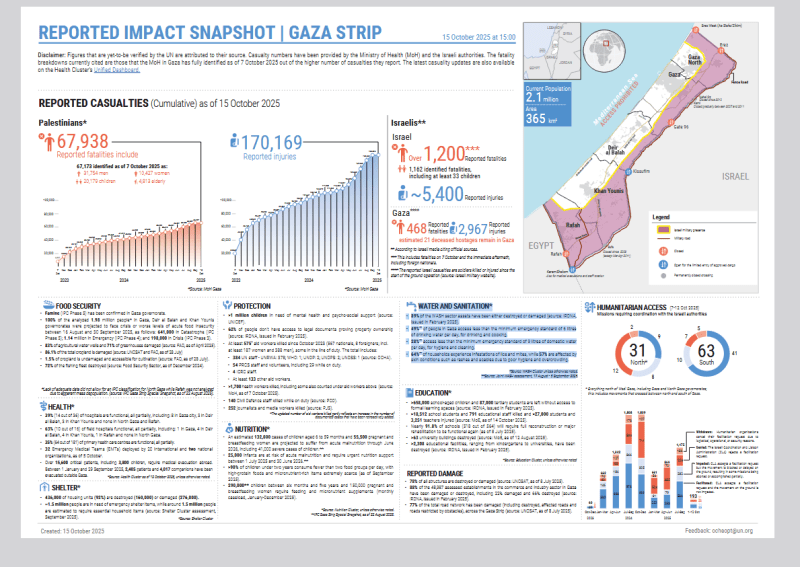
Reported impact snapshot | Gaza Strip (15 October 2025)
PROTECTION
• >1 million children in need of mental health and psycho-social support (source: UNICEF).
• 62% of people don't have access to legal documents proving property ownership (source: IRDNA, issued in February 2025).
• At least 575* aid workers killed since October 2023 (567 nationals, 8 foreigners; incl. at least 187 women and 388 men), some in the line of duty. The total includes:
• 384 UN staff - UNRWA: 378; WHO: 1; UNDP: 2; UNOPS: 2; UNDSS: 1 (source: OCHA).
• 54 PRCS staff and volunteers, including 29 while on duty.
• 4 ICRC staff.
• At least 133 other aid workers.
• >1,700 health workers killed, including some also counted under aid workers above (source: MoH, as of 7 October 2025).
• 140 Civil Defence staff killed while on duty (source: PCD).
• 252 journalists and media workers killed (source: PJS).HEALTH*
• 39% (14 out of 36) of hospitals are functional, all partially, including: 8 in Gaza city, 3 in Deir
al Balah, 3 in Khan Younis and none in North Gaza and Rafah.
• 63% (10 out of 16) of field hospitals functional, all partially, including: 1 in Gaza, 4 in Deir
al Balah, 4 in Khan Younis, 1 in Rafah and none in North Gaza.
• 35% (64 out of 181) of primary health care centres are functional, all partially.
• 32 Emergency Medical Teams (EMTs) deployed by 20 international and two national organizations, as of 5 October.
• Over 15,600 critical patients, including 3,800 children, require medical evacuation abroad.
Between 1 January and 29 September 2025, 2,405 patients and 4,017 companions have been evacuated outside Gaza. *Source: Health Cluster as of 12 October 2025, unless otherwise noted.NUTRITION*
• An estimated 132,000 cases of children aged 6 to 59 months and 55,500 pregnant and
breastfeeding women are projected to suffer from acute malnutrition through June
2026, including 41,000 severe cases of children.**
• 25,000 infants are at risk of acute malnutrition and require urgent nutrition support
between 1 July 2025 and 30 June 2026.**
• >90% of children under two years consume fewer than two food groups per day, with
high-protein foods and micronutrient-rich items extremely scarce (as of September
2025).
• 290,000** children between six months and five years and 150,000 pregnant and
breastfeeding women require feeding and micronutrient supplements (monthly
caseload, January-December 2025)WATER AND SANITATION
• 89% of the WASH sector assets have been either destroyed or damaged (source: IRDNA, issued in February 2025).
• 49%** of people in Gaza access less than the minimum emergency standard of 6 litres of drinking water per day, for drinking and cooking.
• 28%** access less than the minimum emergency standard of 9 litres of domestic water per day, for hygiene and cleaning.
• 64%** of households experience infestations of lice and mites, while 57% are affected by skin conditions such as rashes and scabies due to poor hygiene and overcrowding.
*Source: WASH Cluster unless otherwise noted.
**Source: Joint WASH assessment, 17 August - 5 September 202520 Oct 2025. Dr. Mohammed Abu Salmiya, Director of Al-Shifa Medical Complex, has issued an urgent plea on behalf of amputees and cancer patients in Gaza, calling on the international community and global institutions to act immediately to save lives. In press statements, Dr. Abu Salmiya confirmed that nearly 2,000 amputees and over 5,000 cancer patients are in urgent need of medical treatment abroad.
ESPAÑOL
Resumen del impacto | Franja de Gaza (15 de octubre de 2025)PROTECCIÓN• Más de 1 millón de niños necesitan apoyo psicosocial y de salud mental (fuente: UNICEF).• El 62 % de la población carece de acceso a documentos legales que acrediten la propiedad (fuente: IRDNA, publicado en febrero de 2025).• Al menos 575* trabajadores humanitarios han muerto desde octubre de 2023 (567 nacionales, 8 extranjeros; incluyendo al menos 187 mujeres y 388 hombres), algunos en acto de servicio.El total incluye:• 384 funcionarios de la ONU: UNRWA: 378; OMS: 1; PNUD: 2; UNOPS: 2; UNDSS: 1 (fuente: OCHA).• 54 funcionarios y voluntarios de la Media Luna Roja Palestina (MLRP), incluyendo 29 en servicio.• 4 funcionarios del CICR.• Al menos 133 trabajadores humanitarios más.• Más de 1700 trabajadores sanitarios murieron, incluyendo algunos contabilizados como trabajadores humanitarios (fuente: Ministerio de Salud, al 7 de octubre de 2025).• 140 miembros de la Defensa Civil murieron en servicio (fuente: PCD).• 252 periodistas y trabajadores de medios de comunicación murieron (fuente: PJS). SALUD*• El 39 % (14 de 36) de los hospitales funcionan, todos parcialmente, incluyendo: 8 en la ciudad de Gaza, 3 en Deir al Balah, 3 en Khan Younis y ninguno en el norte de Gaza ni en Rafah.• El 63 % (10 de 16) de los hospitales de campaña funcionan, todos parcialmente, incluyendo: 1 en Gaza, 4 en Deir al Balah, 4 en Khan Younis, 1 en Rafah y ninguno en el norte de Gaza.• El 35 % (64 de 181) de los centros de atención primaria funcionan, todos parcialmente.• 32 Equipos Médicos de Emergencia (EMT) desplegados por 20 organizaciones internacionales y dos nacionales, al 5 de octubre.• Más de 15.600 pacientes críticos, incluidos 3.800 niños, requieren evacuación médica al extranjero. Entre el 1 de enero y el 29 de septiembre de 2025, 2.405 pacientes y 4.017 acompañantes fueron evacuados fuera de Gaza. *Fuente: Grupo de Salud al 12 de octubre de 2025, salvo indicación contraria.NUTRICIÓN*• Se estima que 132.000 casos de niños de 6 a 59 meses y 55.500 mujeres embarazadas y lactantes sufrirán desnutrición aguda hasta junio de 2026, incluidos 41.000 casos graves de niños.**• 25.000 lactantes corren riesgo de desnutrición aguda y requieren apoyo nutricional urgente entre el 1 de julio de 2025 y el 30 de junio de 2026.**• Más del 90 % de los niños menores de dos años consumen menos de dos grupos de alimentos al día, y los alimentos ricos en proteínas y micronutrientes son extremadamente escasos (a septiembre de 2025).• 290.000** niños de entre seis meses y cinco años y 150.000 mujeres embarazadas y lactantes necesitan alimentación y suplementos de micronutrientes (número de casos mensuales, enero-diciembre de 2025)AGUA Y SANEAMIENTO• El 89% de los activos del sector WASH han sido destruidos o dañados (fuente: IRDNA, publicado en febrero de 2025).• El 49%** de la población de Gaza tiene acceso a menos del estándar mínimo de emergencia de 6 litros de agua potable al día para beber y cocinar.• El 28%** tiene acceso a menos del estándar mínimo de emergencia de 9 litros de agua doméstica al día para higiene y limpieza.• El 64%** de los hogares sufre infestaciones de piojos y ácaros, mientras que el 57% padece afecciones cutáneas como erupciones cutáneas y sarna debido a la falta de higiene y el hacinamiento. *Fuente: Grupo Sectorial WASH, salvo indicación contraria. **Fuente: Evaluación conjunta de WASH, 17 de agosto - 5 de septiembre de 2025.20 octubre 2025.El Dr. Mohammed Abu Salmiya, director del Complejo Médico Al-Shifa, ha hecho un llamamiento urgente en favor de las personas amputadas y los pacientes con cáncer en Gaza, instando a la comunidad internacional y a las instituciones globales a actuar de inmediato para salvar vidas. En declaraciones a la prensa, el Dr. Abu Salmiya confirmó que casi 2.000 personas amputadas y más de 5.000 pacientes con cáncer necesitan tratamiento médico urgente en el extranjero.The only confirmed fact is that there is no confirmed death toll in Gaza. El único hecho confirmado es que no hay un número confirmado de muertos en Gaza. ENG ESP
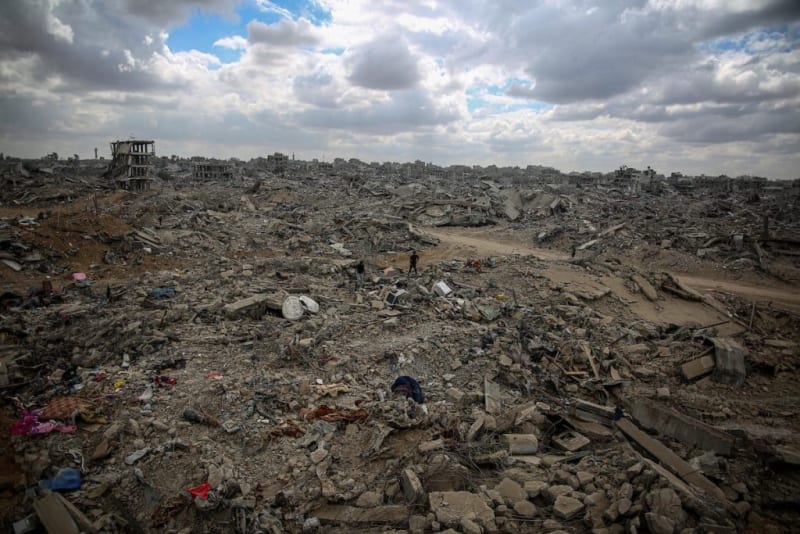
ENGLISH
The Burden of Imprecision: on the limitation of statistics
The death toll in Gaza remains unknown, and statistics have become a contested tool to understand the scale of the genocide. But even if we had an accurate number of deaths, we still wouldn’t understand the depth of its meaning.The Zionist entity has killed between 65,000 and 680,000 Palestinians in Gaza since October 7. The range is staggering, although the larger number is not necessarily the ceiling; it is simply the one we know of.
The first number comes from the Gaza Ministry of Health, which collates data on every single martyr, including their full name, ID number, age, place of residence, birthday, and gender. In a Drop Site interview with Dr. Zaher al-Wahaidi, the Director of the Information Center, he describes how the identity of each martyr is corroborated and counted by every hospital that receives the injured. Not included in the number are those trapped underneath the rubble of collapsed buildings or those who die “indirect deaths.” These include children who are starved to death, cancer patients who can’t access treatment, or those who are killed by disease because of a collapsed healthcare system. The only ones they count in the official toll are those killed by the impact of a missile.
680,000 is the new projected death toll, based on the rate, longevity, and intensity of Zionist brutality. Many have now assumed that number in their vocabulary, rightfully arguing that 65,000 is such a severe undercount that reciting it is itself a form of genocide denial.
The only confirmed fact is that there is no confirmed death toll in Gaza.
Photo: Palestinians returning to the Al-Nafaq area in Gaza City are met with scenes of widespread destruction and devastation, on October 14, 2025. (Photo: Omar Ashtawy/APA Images)
ESPAÑOL
El peso de la imprecisión: sobre la limitación de las estadísticasEl número de muertos en Gaza sigue siendo desconocido, y las estadísticas se han convertido en una herramienta controvertida para comprender la magnitud del genocidio. Pero incluso si tuviéramos una cifra exacta de muertes, seguiríamos sin comprender la profundidad de su significado.La entidad sionista ha asesinado entre 65.000 y 680.000 palestinos en Gaza desde el 7 de octubre.El rango es asombroso, aunque la cifra más alta no es necesariamente el límite; es simplemente la que conocemos.La primera cifra proviene del Ministerio de Salud de Gaza, que recopila datos sobre cada mártir, incluyendo su nombre completo, número de identificación, edad, lugar de residencia, fecha de nacimiento y género. En una entrevista con Drop Site, el Dr. Zaher al-Wahaidi, director del Centro de Información, describe cómo la identidad de cada mártir es corroborada y contabilizada por cada hospital que recibe a los heridos.No se incluyen en la cifra las personas atrapadas bajo los escombros de los edificios derrumbados ni las que fallecen indirectamente. Entre ellos se incluyen niños que mueren de hambre, pacientes de cáncer que no pueden acceder a tratamiento o quienes fallecen por enfermedades debido al colapso del sistema sanitario.Los únicos que se incluyen en el recuento oficial son los fallecidos por el impacto de un proyectil.680.000 es la nueva estimación de muertos, basada en la tasa, la longevidad y la intensidad de la brutalidad sionista. Muchos han asumido esa cifra, argumentando con razón que 65.000 es una cifra tan inferior a la real que mencionarla constituye en sí misma una forma de negación del genocidio.El único hecho confirmado es que no hay un número confirmado de muertos en Gaza.Fotografía: Los palestinos que regresan a la zona de Al-Nafaq en la ciudad de Gaza se encuentran con escenas de destrucción y devastación generalizadas, el 14 de octubre de 2025. (Foto: Omar Ashtawy/APA Images)UNRWA Situation Report. Gaza Strip and the occupied West Bank, including East Jerusalem. Informe Gaza, Cisjordania, Jerusalén Este
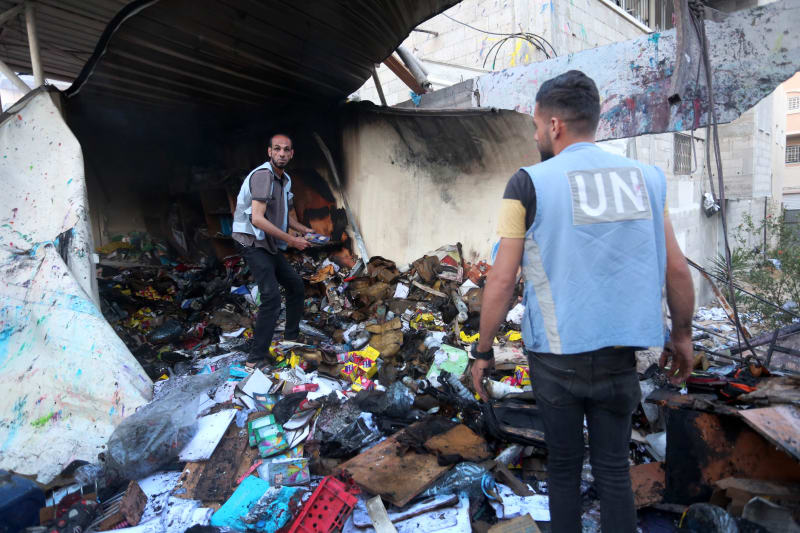
ENGLISH
Posted 15 Oct 2025
HighlightsThe Gaza Strip
-On 10 October, a ceasefire entered into force across the Gaza strip.Following the ceasefire, large-scale population movements were recorded by the Site Management Cluster across several areas, including from southern Gaza towards the north (~309,699 displacement movements) and from west to east within Khan Younis governorate (~22,700 displacement movements) from 10 to 12 October.
-Welcoming the ceasefire announcement, UNRWA Commissioner-General shared his hope that “it will bring respite to people who survived the worst bombardment, displacement, loss and grief for two long years.” He further called on all member states to “support UNRWA to do its work to assist people in need in the coming critical period,” noting that “UNRWA has food, medicines and other basic supplies ready to go to Gaza.”
-UNRWA has enough food in warehouses in Jordan and Egypt to supply the entire population for three months, including food parcels for 1.1 million people and flour for 2.1 million individuals. In addition, UNRWA has shelter supplies outside of Gaza sufficient to reach up to 1.3 million people.
-The Shelter Cluster reported that most people in Gaza reside in inadequate shelters that fail to meet basic emergency standards, leaving them exposed to harsh winter conditions.
-The UN Satellite Centre published a preliminary analysis showing that, as of 23 September, the extent of damage in Gaza City encompassed approximately 83 per cent of all structures, with an estimated 81,159 housing units damaged.
-OCHA reported that an average of four aid workers have been killed each week in the Gaza Strip so far in 2025, and at least 565 aid workers have been killed since 7 October 2023. Among them, UNRWA recorded over 370 workers killed since the war began (306 UNRWA personnel, in addition to 72 people who were supporting UNRWA activities[2]), as of 9 October 2025.The occupied West Bank including East Jerusalem
-With the 2025 olive harvest season which began in the West Bank on 9 October, Israeli settler violence targeting Palestinian communities and agriculture continued unabated, with attacks and harassment reported across the West Bank.
-Movement restrictions were tightened across the West Bank by Israeli forces, including the deployment of mobile checkpoints, the closure of road gates, and the erection of cement blocks and other obstacles.ESPAÑOL
Informe de Situación n.° 192 de UNRWA sobre la Crisis Humanitaria en la Franja de Gaza y la Cisjordania ocupada, incluida Jerusalén OrientalPublicado el 15 de octubre de 2025Aspectos destacadosLa Franja de Gaza- El 10 de octubre entró en vigor un alto el fuego en toda la Franja de Gaza. Tras el alto el fuego, el Grupo de Gestión de Sitios registró movimientos de población a gran escala en varias zonas, incluyendo del sur de Gaza hacia el norte (unos 309 699 desplazamientos) y de oeste a este dentro de la gobernación de Jan Yunis (unos 22 700 desplazamientos) del 10 al 12 de octubre.- El Comisionado General de UNRWA acogió con satisfacción el anuncio del alto el fuego y expresó su esperanza de que este brinde un respiro a las personas que sobrevivieron a los peores bombardeos, desplazamientos, pérdidas y dolor de dos largos años. Además, instó a todos los Estados miembros a apoyar a UNRWA en su labor de asistencia a las personas necesitadas durante el próximo período crítico, señalando que UNRWA cuenta con alimentos, medicamentos y otros suministros básicos listos para ser enviados a Gaza. UNRWA cuenta con suficientes alimentos en almacenes en Jordania y Egipto para abastecer a toda la población durante tres meses, incluyendo paquetes de alimentos para 1,1 millones de personas y harina para 2,1 millones.-Además, UNRWA dispone de suministros de refugio fuera de Gaza suficientes para atender a hasta 1,3 millones de personas. El Grupo Temático de Refugios informó que la mayoría de las personas en Gaza residen en refugios inadecuados que no cumplen con los estándares básicos de emergencia, lo que las expone a las duras condiciones invernales.-El Centro de Satélites de la ONU publicó un análisis preliminar que muestra que, al 23 de septiembre, la magnitud de los daños en la ciudad de Gaza abarcaba aproximadamente el 83 % de todas las estructuras, con un estimado de 81 159 viviendas dañadas.-La OCHA informó que, en lo que va de 2025, un promedio de cuatro trabajadores humanitarios han sido asesinados cada semana en la Franja de Gaza, y al menos 565 trabajadores humanitarios han sido asesinados desde el 7 de octubre de 2023.-Entre ellos, la UNRWA registró más de 370 trabajadores asesinados desde el inicio de la guerra (306 miembros del personal de la UNRWA, además de 72 personas que apoyaban sus actividades[2]), hasta el 9 de octubre de 2025.Cisjordania, incluida Jerusalén Oriental- Con el inicio de la temporada de cosecha de aceitunas de 2025 en Cisjordania el 9 de octubre, la violencia de los colonos israelíes contra las comunidades palestinas y la agricultura continuó sin cesar, con ataques y acoso registrados en toda Cisjordania.- Las fuerzas israelíes endurecieron las restricciones de movimiento en Cisjordania, incluyendo el despliegue de puestos de control móviles, el cierre de controles en las carreteras y la construcción de bloques de cemento y otros obstáculos.Palestine. Humanitarian situation. Problemas sociosanitarios. ENG ESP
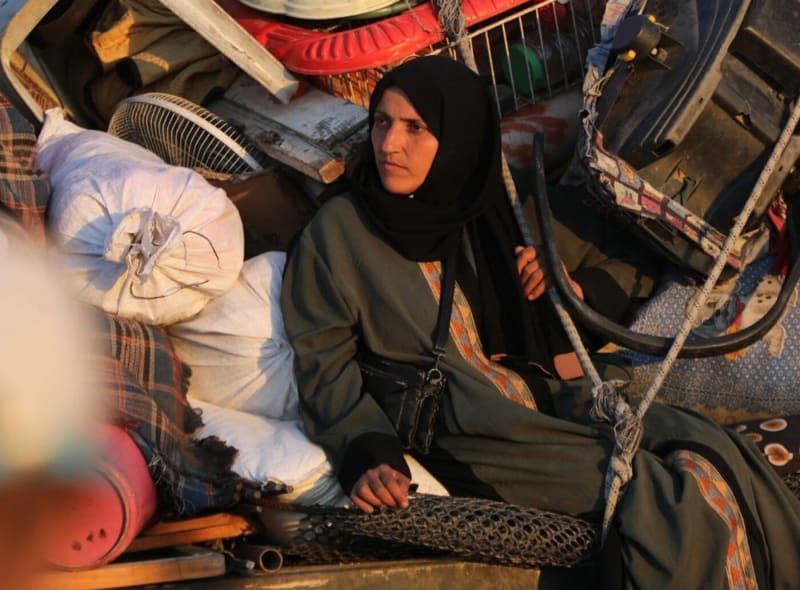
2 Oct 2025
Humanitarian Situation Update #327 | Gaza Strip
Key Highlights
- People in Gaza city are facing deteriorating access to means of survival amid intensified bombardment, collapsing lifelines, and a growing number of aid organizations forced to suspend operations.
- Cooked meal provision in northern Gaza has dropped by 70 per cent, with only eight kitchens currently operational, the Food Security Sector reports.
- One million people are accessing less than the emergency minimum of six litres of drinking water per day, according to a recent assessment by water, sanitation and hygiene partners.
- The UN and its partners continue to face physical and bureaucratic impediments, preventing them from providing lifesaving assistance at scale in the Gaza Strip.
- Attacks on or near hospitals and other health facilities continue to be reported.
- Environmental damage in the Gaza Strip has dramatically worsened since June 2024, according to the UN Environment Programme.
Challenges Facing the Health-Care System
- On 28 October, Al-Helou maternity hospital in Gaza city sustained damage due to nearby strikes, causing panic and fear among patients and medical staff, but no injuries were reported. Citing MoH staff, MSF reported that at the time of the incident, there were 12 newborns in the neonatal intensive care unit, five patients in internal medicine department, and two obstetric patients in the hospital, among others. On 29 September, OHCHR stated that “Israel’s military attacks on and around hospitals in Gaza city are leaving sick and injured civilians with nowhere to turn to for life-saving care, as escalating attacks on civilians and civilian infrastructure are leading to countless casualties,” noting that it recorded at least 17 attacks on or near health facilities across Gaza city between 16 and 28 September. On 29 September, at the Nasser Medical Complex in Khan Younis, a nurse was critically injured by a gunshot to the head while performing his duties inside the hospital.
- Neonatal care across the Gaza Strip is critically strained amid severe supply shortages and escalating insecurity, with facilities operating far beyond their intended capacity. The Head of the Neonatal Unit at Nasser, Dr. Hatem Duhair, reported that the neonatal unit is functioning under catastrophic conditions; the facility was designed to accommodate 17 infants, but is caring for 26, with numbers expected to increase. In some cases, two newborns are sharing a single incubator, and additional incubators have been placed between existing units to manage the high caseload. Dr. Duhair added that only five ventilators are available for all 26 infants, forcing medical teams to prioritize which infants receive life-saving support, including those in need of urgent surgery. Dr. Duhair noted that the increase in births is directly linked to the influx of displaced families from northern Gaza, placing further strain on already overstretched resources. The neonatal unit is currently operating at 150 to 170 per cent of its designed capacity, while the overflow nursery designed for nine infants is now hosting 30, he added.
- Medicine and medical consumables in the Gaza Strip are at crisis levels. On 25 September, MoH in Gaza reported that 54 per cent of essential drugs and 66 per cent of medical consumables were at zero-stock levels. In emergency departments, the situation is particularly alarming, with 45 per cent of items unavailable, including surgical supplies, critically affecting life-saving procedures. The MoH is also facing severe shortages of blood units, blood bags and transfusion sets, with supplies expected to run out imminently.
- A surge in cases of infectious diseases is a growing concern. According to the Health Cluster, over 1,300 suspected cases of meningitis (primarily viral) have been reported between May and September 2025, with no deaths to date. In parallel, since June 2025, 122 cases of Guillain-Barré Syndrome (GBS) have been recorded, along with 16 associated deaths; these included 19 GBS cases and three deaths reported in September, the Health Cluster reported. The response to GBS is severely constrained by the limited availability of intravenous immunoglobulin (IVIG) and plasma filters, which are essential for treatment. The Health Cluster noted that the last shipment of Plasma filters entered Gaza in mid-September while the IVIG is planned to enter in early October 2025.
ESPAÑOL
Actualización de la situación humanitaria n.° 327 | Franja de Gaza
Puntos ClaveLa población de la ciudad de Gaza se enfrenta a un deterioro del acceso a los medios de subsistencia en medio de la intensificación de los bombardeos, el colapso de los servicios básicos y un creciente número de organizaciones de ayuda obligadas a suspender sus operaciones.El suministro de comidas cocinadas en el norte de Gaza se ha reducido en un 70%, con solo ocho cocinas operativas actualmente, según informa el Sector de Seguridad Alimentaria.Un millón de personas tienen acceso a menos del mínimo de emergencia de seis litros de agua potable al día, según una evaluación reciente realizada por socios en materia de agua, saneamiento e higiene.La ONU y sus socios siguen enfrentándose a obstáculos físicos y burocráticos que les impiden brindar asistencia vital a gran escala en la Franja de Gaza.Se siguen reportando ataques a hospitales y otros centros de salud o sus inmediaciones.El daño ambiental en la Franja de Gaza ha empeorado drásticamente desde junio de 2024, según el Programa de las Naciones Unidas para el Medio Ambiente.Problemas en el Sistema de SaludEl 28 de octubre, el hospital de maternidad Al-Helou, en la ciudad de Gaza, sufrió daños debido a ataques en las inmediaciones, lo que provocó pánico y temor entre los pacientes y el personal médico, pero no se reportaron heridos.Citando a personal del Ministerio de Salud, MSF informó que, en el momento del incidente, había 12 recién nacidos en la unidad de cuidados intensivos neonatales, cinco pacientes en el departamento de medicina interna y dos pacientes obstétricas en el hospital, entre otros.El 29 de septiembre, el ACNUDH declaró que “los ataques militares de Israel contra los hospitales de la ciudad de Gaza y sus alrededores están dejando a los civiles enfermos y heridos sin un lugar al que acudir para recibir atención vital, mientras que la escalada de ataques contra civiles e infraestructuras civiles está causando innumerables víctimas”, señalando que registró al menos 17 ataques contra o cerca de centros de salud en la ciudad de Gaza entre el 16 y el 28 de septiembre.El 29 de septiembre, en el Complejo Médico Nasser de Khan Younis, un enfermero resultó gravemente herido por un disparo en la cabeza mientras realizaba sus tareas dentro del hospital.La atención neonatal en la Franja de Gaza se encuentra bajo una presión crítica debido a la grave escasez de suministros y la creciente inseguridad, con instalaciones que operan muy por encima de su capacidad prevista.El Dr. Hatem Duhair, jefe de la Unidad Neonatal en Nasser, informó que la unidad neonatal está funcionando en condiciones catastróficas; la instalación fue diseñada para albergar a 17 bebés, pero está atendiendo a 26, y se espera que la cantidad aumente. En algunos casos, dos recién nacidos comparten una sola incubadora, y se han colocado incubadoras adicionales entre las unidades existentes para gestionar la alta carga de trabajo.El Dr. Duhair agregó que solo hay cinco respiradores disponibles para los 26 bebés, lo que obliga a los equipos médicos a priorizar qué bebés reciben apoyo vital, incluidos aquellos que necesitan cirugía urgente. El Dr. Duhair señaló que el aumento de nacimientos está directamente relacionado con la afluencia de familias desplazadas del norte de Gaza, lo que ejerce una mayor presión sobre los recursos ya sobrecargados.La unidad neonatal opera actualmente entre el 150% y el 170% de su capacidad, mientras que la sala de recién nacidos, diseñada para nueve bebés, ahora alberga a 30, añadió.Los medicamentos y los insumos médicos en la Franja de Gaza se encuentran en niveles críticos.El 25 de septiembre, el Ministerio de Salud de Gaza informó que el 54% de los medicamentos esenciales y el 66% de los insumos médicos se encontraban en niveles de inventario cero.En los servicios de urgencias, la situación es particularmente alarmante, con el 45% de los artículos no disponibles, incluyendo suministros quirúrgicos, lo que afecta gravemente los procedimientos vitales.El Ministerio de Salud también enfrenta una grave escasez de unidades de sangre, bolsas de sangre y equipos de transfusión, y se espera que los suministros se agoten de forma inminente.El aumento repentino de casos de enfermedades infecciosas es una preocupación creciente. Según el Grupo de Salud, se han reportado más de 1300 casos sospechosos de meningitis (principalmente viral) entre mayo y septiembre de 2025, sin fallecimientos hasta la fecha.Paralelamente, desde junio de 2025, se han registrado 122 casos de síndrome de Guillain-Barré (SGB), junto con 16 fallecimientos asociados; estos incluyen 19 casos de SGB y tres fallecimientos notificados en septiembre, según informó el Grupo de Salud.La respuesta al SGB se ve gravemente limitada por la disponibilidad limitada de inmunoglobulina intravenosa (IVIG) y filtros de plasma, esenciales para el tratamiento.El Grupo de Salud señaló que el último envío de filtros de plasma entró en Gaza a mediados de septiembre, mientras que se prevé que la IVIG entre a principios de octubre de 2025.Gaza. 680.000 Palestinians killed/ asesinados by/ por Israel ENG ESP
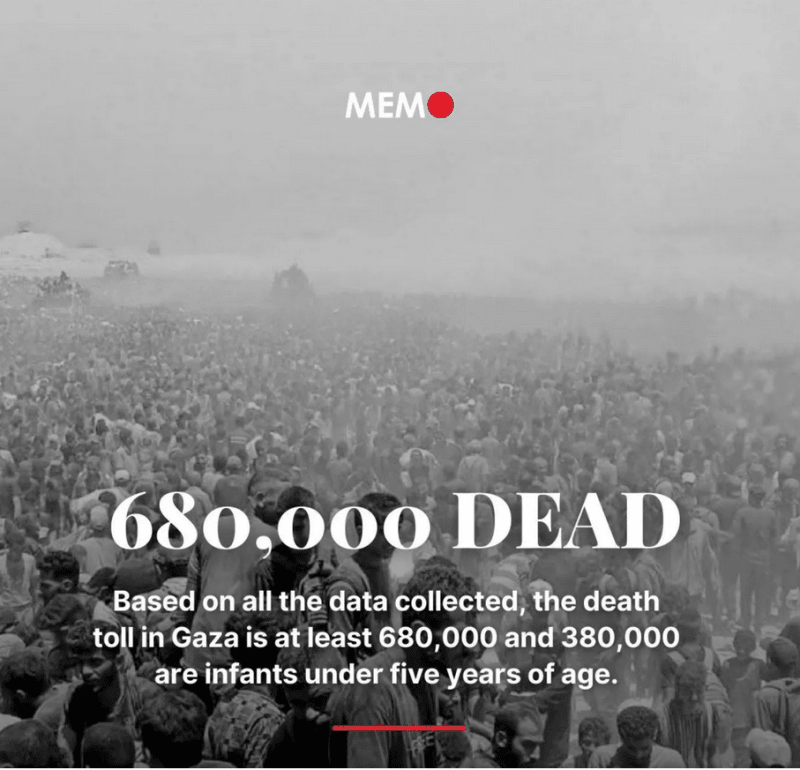
ENGLISH (original work, published July 11, 2025)
Gaza’s Real Death Toll: 680,000 Killed – 70% Are Children
In their forensic article Skewering History: The Odious Politics of Counting Gaza’s Dead, Dr Richard Hil and Dr Gideon Polya dismantle the official narrative on Gaza’s death toll — and the numbers they present are shattering.
The authors show that when deaths from starvation, disease, and deprivation are included, the true toll by April 2025 was closer to 680,000 Palestinians killed — 12 to 14 times higher than what most outlets report.
The most devastating detail: around 380,000 of these deaths were infants under five, and 479,000 were children in total — meaning nearly 70% of Gaza’s dead are children.
Save the Children estimates that 20,000 more children remain buried under Gaza’s 51 million tons of rubble, their bodies unrecovered.
The authors note that the Palestinian-to-Israeli death ratio is now 597 to 1 — sixty times higher than Hitler’s infamous 10-to-1 massacre reprisals in Nazi-occupied Rome. This is not a “war” but an industrial-scale slaughter.
And the erasure is deliberate. Almost 250 Palestinian journalists have been killed. International press are banned from Gaza.
Al Jazeera has been banned from Israel, and independent media offices like Haaretz have been attacked — a systematic attempt to silence documentation of the genocide.
Words like “genocide,” “occupation,” and “ethnic cleansing” are banned from use in most Western state broadcasters.
The article also highlights Donald Trump’s own admission, in May 2025, citing intelligence figures that put Gaza’s remaining population at 1.7 million - meaning as many as 700,000 Gazans have been killed or disappeared.
Perhaps most chillingly, Hil and Polya report that a majority of Israelis support the mass expulsion of all Palestinians from Gaza.
A May 2025 poll found that a majority of Israelis support the forced removal of all Palestinians and 65% explicitly invoked the biblical command to “erase Amalek.”
Hil and Polya’s analysis makes clear what the euphemisms and media silences conceal: Gaza is living through one of the deadliest episodes of mass killing since World War II — and the vast majority of its victims are children.
ESPAÑOL
La relatora de la ONU sobre los territorios palestinos ocupados, Francesca Albanese, ha asegurado este lunes que el número de muertos en la Franja de Gaza puede llegar a ser diez veces más de lo calculado por Hamás, que cifra en 65.000 los palestinos fallecidos desde el 7 de octubre de 2023.
"Deberíamos empezar a pensar en 680.000 porque este es el número que algunos académicos y científicos afirman que es la verdadera cifra de muertos en Gaza", ha sostenido la italiana durante una rueda de prensa celebrada en Ginebra.
Según Albanese, los investigadores han llegado a esta cifra en función de los cálculos sobre el nivel de destrucción en el enclave palestino y del número de habitantes que parecen quedar allí.
Los datos proporcionados por Albanese son fruto de una investigación llevada a cabo por Richard Hil, profesor de la Universidad Griffith (Queensland, Australia), y por el escritor Gideon Polya. La cifra, que contempla no solo las muertes por los ataques israelíes sino también por hambre y otras carencias, surge a raíz de una fórmula publicada en 2024 en la revista The Lancet, cuyos autores estiman que las muertes indirectas en los conflictos armados "son entre tres y quince veces superiores a las muertes directas".
De acuerdo con los investigadores, 544.000 personas podrían haber muerto indirectamente en Gaza, mientras que el resto lo habría hecho a manos de las Fuerzas Armadas israelíes. La relatora de la ONU ha añadido que la cifra estimada es "difícil" de comprobar, ya que a los investigadores se les prohíbe acceder a la Franja.
Sin embargo, ha destacado que de ser verdadera, serían unos 380.000 los menores de cinco años que han fallecido hasta ahora en el enclave. "Tomará años verificar el número verdadero de víctimas y recuperar los restos humanos de esta catástrofe, como ocurrió en Bosnia", ha añadido Albanese, una de las primeras personas en calificar de "genocidio" lo que está ocurriendo en la Franja.
El presidente del Consejo de Administración de la Corporación RTVE, José Pablo López Sánchez, comparece ante la Comisión Mixta de Control Parlamentario RTVE y sus Sociedades del Congreso de los Diputados este jueves. El presidente de RTVE propondrá mañana al Consejo de Administración retirar a España de Eurovisión si Israel participa Además, la representante de la ONU ha señalado que 1.581 trabajadores humanitarios, 252 periodistas y 346 trabajadores de Naciones Unidos han sido asesinados en el enclave. Asimismo, ha denunciado que 10.000 palestinos han sido detenidos arbitrariamente "por una ocupación ilegal, que ha estado privando de comida, torturando e incluso violando" a la población". Además, ha afirmado que 75 palestinos detenidos habrían muerto bajo custodia de Israel.
A esta situación se suma el hecho, según la relatora, de que los palestinos "continúan siendo sacados de sus casas en medio de la noche" en los territorios ocupados. "Hogares, refugios, hospitales, colegios y centros comerciales siguen siendo destruidos. Más del 85% de Gaza está en ruinas", ha sostenido Albanese, para quien ha resultado un "doloroso honor" comparecer ante la prensa tras 710 días de "horror absoluto".
Con respecto a la operación israelí para tomar la Ciudad de Gaza, la relatora ha destacado que la operación no solo "devastará" a los palestinos sino que también pondrá en riesgo a los rehenes que siguen secuestrados en la Franja. Además, ha acusado a Israel de utilizar "armas que nunca antes hemos visto, así como armamento recién ensamblado que destruye barrios enteros y lo que queda de los edificios donde la gente ha buscado refugio". "Se trata del último pedazo de tierra donde la guerra debe ser imposible antes de avanzar en su limpieza étnica y de dirigirse, probablemente, a Cisjordania", ha sentenciado. Almodóvar, este lunes, en Sol. Artistas españoles como Almodóvar o García Montero ponen su voz para nombrar a los 18.500 niños muertos en Gaza Albanese también ha señalado que Cisjordania vive bajo una "intensa presión".
Según la relatora, más de 1.000 palestinos han sido asesinados en el territorio desde el 7 de octubre, de los cuales 212 son niños. Asimismo, la representante de la ONU ha alertado de que las incursiones israelíes en territorio palestino han aumentado en un 22%, en comparación con los años anteriores.
El número de "asesinatos selectivos" también ha subido y se habría convertido en el "más grave" desde la Segunda Intifada. Además, ha situado en 40.000 el número de palestinos obligados a desplazarse.
Albanese, sancionada por EEUU
La relatora de la ONU ha sido sancionada por Estados Unidos tras haber denunciado el "genocidio" en Gaza y no podrá viajar a Nueva York para presentar su informe a la Asamblea General de la ONU, que se reunirá aproximante, a menos que se le permita hacerlo a última hora.
Según informó a principios de julio el secretario de Estado de EEUU, Marco Rubio, Albanese fue sancionada por colaborar con la Corte Penal Internacional para procesar a ciudadanos estadounidenses e israelíes relacionados con la ofensiva.
"Albanese ha colaborado directamente con la Corte Penal Internacional en iniciativas para investigar, arrestar, detener o enjuiciar a ciudadanos de Estados Unidos o Israel, sin el consentimiento de ambos países", afirmó Rubio en un comunicado. "Ni Estados Unidos ni Israel son parte del Estatuto de Roma, lo que convierte esta acción en una grave violación de la soberanía de ambos países", sentenció.
OCHA Reported impact snapshot | Gaza Strip, 10 September 2025
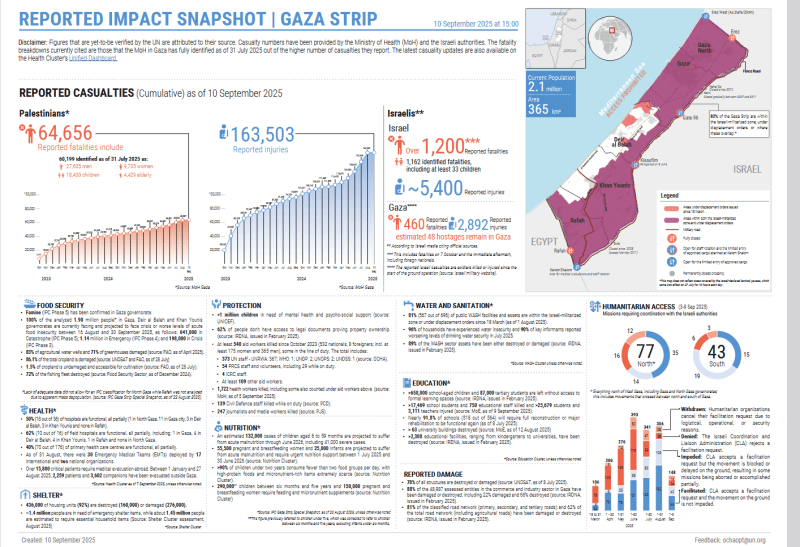
OCHA Reported impact snapshot | Gaza Strip, 10 September 2025
More than 30 Palestinians sustain permanent or temporary disabilities each day in the #Gaza Strip
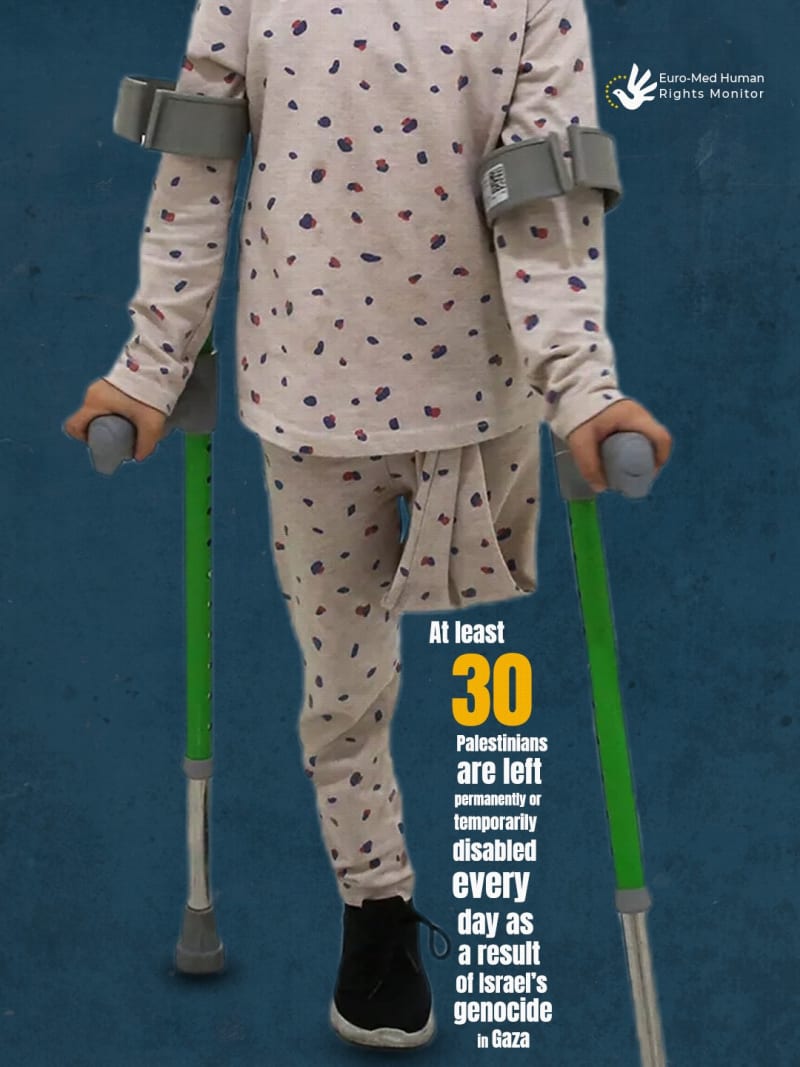
26 August 2025
More than 30 Palestinians sustain permanent or temporary disabilities each day in the #Gaza Strip, as part of the genocide carried out by Israel since October 2023. The number of persons with disabilities in Gaza has risen by about 35% compared to the period before the genocide, as a direct result of Israeli attacks deliberately targeting civilians. The Israeli army systematically employed excessive force and highly destructive weapons to maximise deaths and injuries, causing permanent disabilities and severe physical and psychological suffering to thousands of Palestinians. This forms part of Israel’s systematic policy of destruction, integral to the ongoing crime of genocide.Israel, carnage in Gaza City. Israel, matanza en Gaza City
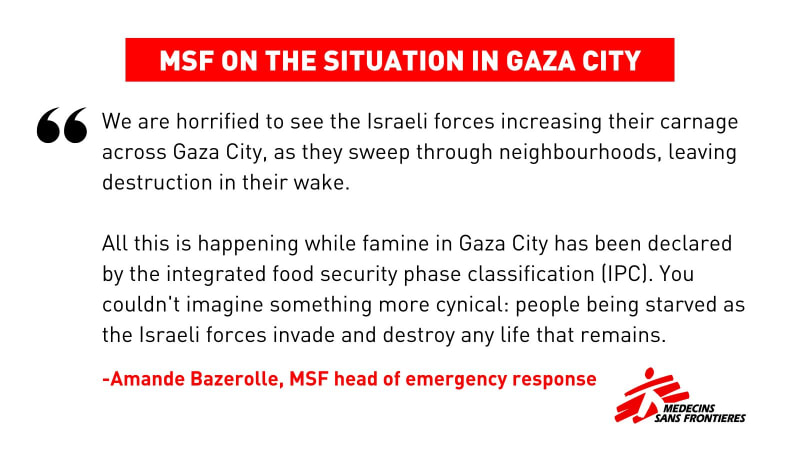
ENGLISH
The Israeli forces are increasing their carnage in Gaza City, while famine has been declared in the city by the integrated food security phase classification. Medicines Sans Frontieres. 22 August 2025
Amande Bazerolle, the head of our emergency response in Gaza, shares her reaction to the current situation in Gaza City: “We are horrified to see the Israeli forces increasing their carnage across Gaza City, as they sweep through neighbourhoods, leaving destruction in their wake. At the same time, continued strikes are forcing people, including MSF staff, to flee their homes once again, and we are seeing displacement across Gaza City.
“At our clinics in the area, we have seen high patient numbers this week as people move away from the recent bombardments in neighbourhoods, such as Az-Zaytoun.
“All this is happening while famine in Gaza City has been declared by the integrated food security phase classification (IPC). You couldn't imagine something more cynical: people being starved as the Israeli forces invade and destroy any life that remains.
“This will lead to a complete and utter humanitarian disaster. As the Israeli forces accelerate their campaign of genocide and ethnic cleansing by expanding their military ground invasion into Gaza City, Palestinians trapped there face starvation, disease, and death.
“We have seen this repeatedly before: the mass destruction of civilian infrastructure, the forced displacement of millions into ever-shrinking, uninhabitable areas, and the systematic denial of food, water and aid".
“We call on the Israeli forces to stop their military invasion and reiterate our call for an immediate and sustained ceasefire.”
ESPAÑOL
Las fuerzas israelíes están incrementando su carnicería en la ciudad de Gaza, mientras que la clasificación integrada de la fase de seguridad alimentaria ha declarado la hambruna en la ciudad. Médicos Sin Fronteras MSF. 22 de agosto de 2025
Amande Bazerolle, jefa de nuestra respuesta de emergencia en Gaza, comparte su reacción ante la situación actual en la ciudad de Gaza: "Nos horroriza ver cómo las fuerzas israelíes intensifican su masacre en la ciudad de Gaza, arrasando barrios y dejando tras de sí la destrucción".
Al mismo tiempo, los continuos ataques obligan a la población, incluido el personal de MSF, a huir de sus hogares una vez más, y estamos presenciando desplazamientos en toda la ciudad de Gaza.
“En nuestras clínicas de la zona, hemos visto un alto número de pacientes esta semana a medida que la población se aleja de los recientes bombardeos en barrios como Az-Zaytoun. Todo esto ocurre mientras la hambruna en la ciudad de Gaza ha sido declarada por la Clasificación Integrada de Fases de Seguridad Alimentaria (CIF)".
Imposible imaginar algo más cínico: gente muriendo de hambre mientras las fuerzas israelíes invaden y destruyen cualquier vida que quede. Esto conducirá a un desastre humanitario total y absoluto.
A medida que las fuerzas israelíes aceleran su campaña de genocidio y limpieza étnica al expandir su invasión militar terrestre a la ciudad de Gaza, los palestinos atrapados allí se enfrentan al hambre, la enfermedad y la muerte.
“Hemos visto esto repetidamente antes: la destrucción masiva de infraestructura civil, el desplazamiento forzado de millones de personas a áreas cada vez más reducidas e inhabitables y la negación sistemática de alimentos, agua y ayuda".
“Hacemos un llamamiento a las fuerzas israelíes para que detengan su invasión militar y reiteramos nuestro llamamiento a un alto el fuego inmediato y sostenido”.
Hambruna en Gaza, por el asedio de Israel. Famine Declared in Gaza Amid Israeli Blockade. ESP ENG
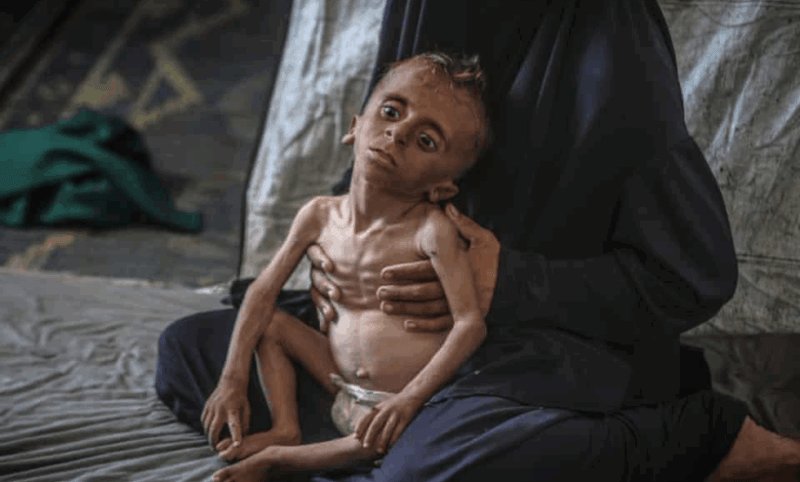
ESPAÑOL
21 de agosto de 2025
La organización cree que podría haberse evitado si no fuera por la "obstrucción sistemática" de Israel
Y afirma que utilizar el hambre como método en un conflicto armado "es un crimen de guerra".
Lo peor se está viviendo en el norte de Gaza y particularmente en Ciudad de Gaza, donde hay un millón de personas y contra la cual Israel prepara una nueva ofensiva militar, pero los datos revelados este viernes indican que "entre mediados de agosto y finales de septiembre de 2025 se prevé que las condiciones empeoren aún más, con una expansión de la hambruna" hacia el centro y el sur del enclave.
En concreto, la Comisión de Revisión de la Hambruna ha señalado en un informe que cumplen los parámetros establecidos y que el territorio se encuentran en la fase 5 de la clasificación, que refleja la falta de acceso extrema a alimentos y agua, el desplazamiento a gran escala y una alta tasa de mortalidad. El texto alerta de que se trata de una hambruna "creada por el hombre" y que, como tal, "puede ser revertida".
ENGLISH
21 August 2025
Famine Declared in Gaza Amid Israeli Blockade.
Famine has been declared for the first time in Gaza City and its surrounding areas, according to the Integrated Food Phase Classification (IPC), the UN-backed global hunger monitor, as Israel continues to block aid from entering the war-torn enclave.
The UN-backed scale issued a report on Friday morning in which it said that famine was taking place in Gaza City and surrounding areas, in an area home to around 500,000 displaced Palestinians. It has raised its classification for Gaza Governorate to Phase 5, the highest level, which is characterised by starvation, destitution and death.
The same classification is projected to be extended to Deir al-Balah in central Gaza and Khan Younis in the south by the end of September.
While the body had previously warned that famine was imminent across Gaza, it had stopped short of making a formal declaration.
Another 1.07 million people – or 54 percent of Gaza’s population – are classified as being under Phase 4, or “emergency” conditions, while 396,000 people (20 percent) are under Phase 3, or “crisis” conditions.
At least 132,000 children under five in Gaza are expected to suffer from acute malnutrition through next June, according to the latest IPC snapshot on the food security crisis in the territory.
That’s more than double the estimates from the IPC, the international system for monitoring world hunger and food security, in May. This includes more than 41,000 severe cases of children at heightened risk of death. The report said “large segments” of Gaza’s population were consuming diets “that fall extremely short in both nutritional quantity and quality”.
“Nutrition supplies for treating and preventing acute malnutrition are close to depletion due to entry restrictions, which may force health facilities to halt treatment,” it said.
Meanwhile, nearly 55,500 malnourished pregnant and breastfeeding women will require urgent nutrition responses, the body said.
It declares famine if three criteria are met: at least 20 percent of households face an extreme lack of food, at least 30 percent of children are suffering acute malnutrition, and two out of every 10,000 are dying each day due to “outright starvation”.
El genocidio de Israel en Gaza llega a un punto crítico con la hambruna
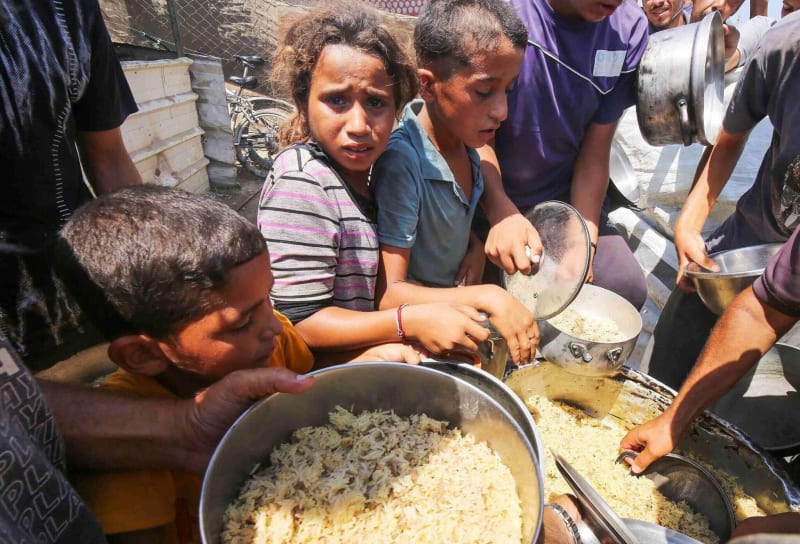
El genocidio de Israel en Gaza llega a un punto crítico con la hambruna
1 agosto 2025
...
La situación ha empeorado drásticamente, ya que el 81% de los hogares declaran consumir pocos alimentos, frente al 33% en abril, y el deterioro más grave se observa en el norte de Gaza. Una tendencia similar puede observarse en la escala de hambre en los hogares, con un 24% experimentando hambre muy severa en julio, en comparación con el 4% en abril.
La mayoría de los hogares (86%) declararon no tener regularmente alimentos de ningún tipo y casi todos (96%) aseguraron haberse acostado con hambre varias veces en el último mes. Casi nueve de cada diez recurrieron a mecanismos de supervivencia extremadamente severos para alimentarse, como correr importantes riesgos de seguridad para obtener alimentos o rebuscar entre la basura.
...
Gaza. Humiliating and deadly tactics by the Israeli army. Crowds waiting for aid. Tácticas humillantes y mortales en cola de espera alimentos. ENG ESP
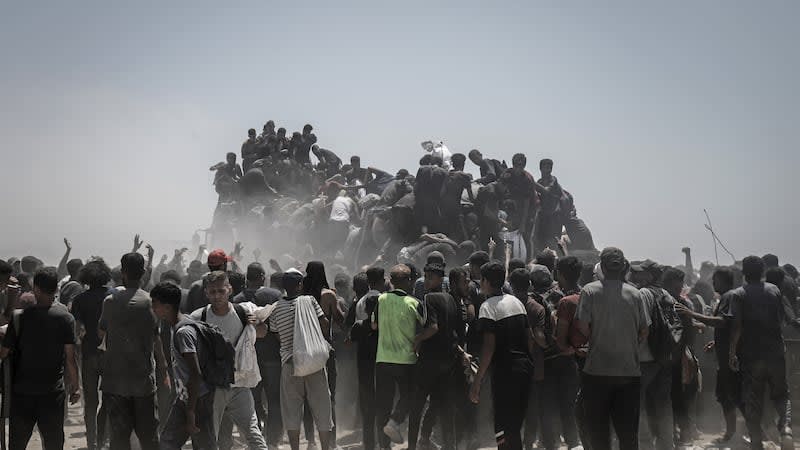
ENGLISH
Striking testimony from Gazans who have escaped the crossfire of the Israeli army during distribution at the Gaza Humanitarian Foundation's aid sites suggests a strategy that legitimises force being used by the military, luring desperate civilians into waves of live fire that can be justified by occupying forces.
Survivors told The National that the pattern is that after waiting all night, crowds are shot at early in the morning before the arrival of tanks, which causes panic among aid-seekers. Fleeing the tanks, they are then shot at by Israeli soldiers for moving in "unauthorised directions".
Children in Gaza learning meaning of grief far too youngChildren in Gaza learning meaning of grief far too young
Read MoreMore than 1,300 Palestinians have been killed while waiting to receive aid - at least 850 of them in the vicinity of aid distribution sites, mostly by Israel's army - since the inception of the US-Israeli backed GHF in May, the UN said last week.
The question is: why? The National spoke to witnesses, experts, victims and others to uncover the circumstances under which starving Gazans are dying by bullets.
The investigation revealed humiliating tactics used by the Israeli army to control crowds waiting for aid, often under inhumane conditions at sites that can only be described as death traps.
ESPAÑOL
"The National" revela nuevos detalles sobre el asesinato sistemático de palestinos por parte del ejército israelí y contratistas privados mientras intentaban recoger ayuda en Gaza.
El impactante testimonio de gazatíes que escaparon del fuego cruzado del ejército israelí durante la distribución de ayuda en los puntos de encuentro de la Fundación Humanitaria de Gaza sugiere una estrategia que legitima el uso de la fuerza por parte del ejército, atrayendo a civiles desesperados hacia oleadas de fuego real que las fuerzas de ocupación pueden justificar.
Los sobrevivientes declararon a The National que la práctica habitual es que, tras esperar toda la noche, la multitud recibe disparos a primera hora de la mañana, antes de la llegada de los tanques, lo que provoca pánico entre los solicitantes de ayuda. Al huir de los tanques, los soldados israelíes les disparan por moverse en "direcciones no autorizadas".
Más de 1300 palestinos han muerto mientras esperaban recibir ayuda —al menos 850 de ellos en las inmediaciones de los centros de distribución, principalmente a manos del ejército israelí— desde la creación de la Fundación de Ayuda Humanitaria Global (FGH), respaldada por Estados Unidos e Israel, en mayo, según declaró la ONU la semana pasada.
La pregunta es: ¿por qué? The National habló con testigos, expertos, víctimas y otros para esclarecer las circunstancias en las que los gazatíes, que sufren hambre, mueren a causa de las balas. La investigación reveló tácticas humillantes empleadas por el ejército israelí para controlar a las multitudes que esperan ayuda, a menudo en condiciones inhumanas en lugares que solo pueden describirse como trampas mortales.
War crimes in Gaza. A macabre game of snipers and drones. Crímenes de guerra en Gaza. Un juego macabro de francotiradores y drones. ENG ESP
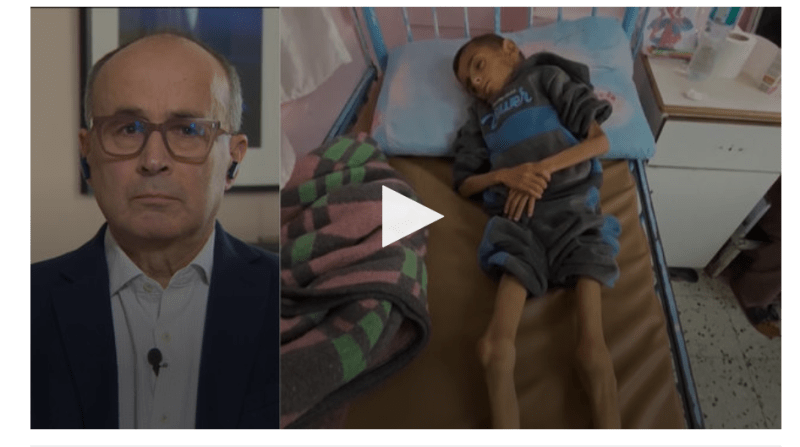
ENGLISH 25 July 2025
“Why Is the World Letting It Happen?”: U.K. Surgeon, Back from Gaza. Dr Nick Maynard
And even more disturbing from that, there is a very clear pattern that the emergency doctors in the ER have recognized, and indeed the surgeons, like me, have recognized, that there is a cluster of injuries to particular body parts on particular days. So, for example, one day there’ll be — most of them will be coming in with gunshot wounds to the head and neck. Another day there’ll be gunshot wounds to the chest, another day to the abdomen and even to the — 12 days ago, we had four young teenage boys, all of whom were admitted with gunshot wounds to the testicles. And the clustering, the pattern we’re seeing is very striking. And it would appear to us that they’re — it’s almost like target practice — playing some sort of game, that we’re going to go for the head today, the abdomen tomorrow, the testicles the day after that. Truly, truly shocking.
ESPAÑOL
¿Cómo es posible? Declaraciones de un cirujano británico tras un mes en Gaza. Dr Nick Maynard
“Están siendo disparados por soldados israelís y por drones xuadricopteros que están por toda la zona en este momento.
Y aún más inquietante. Un patrón muy claro que los médicos de emergencias han reconocido y de hecho cirujanos como yo han reconocido y es que hay un grupo de lesiones en partes particulares del cuerpo en días específicos. Así por ejemplo, un día la mayoría de los heridos vendrán con heridas de bala en la cabeza y el cuello. Otro día habrá heridas de bala en el pecho, otro día en el abdomen e incluso hace 12 días tuvimos cuatro jóvenes adolescentes que fueron admitidos con heridas de bala en los testículos. La agrupación el patrón que estamos viendo es muy sorprendente. Nos parece que están con una práctica de tiro, jugando algún tipo de juego vamos a ir por la cabeza hoy, el abdomen mañana, los testículos el día siguiente. Realmente realmente impactante”
Aid and starvation as weapons. Ayuda y hambre como armas. ENG ESP
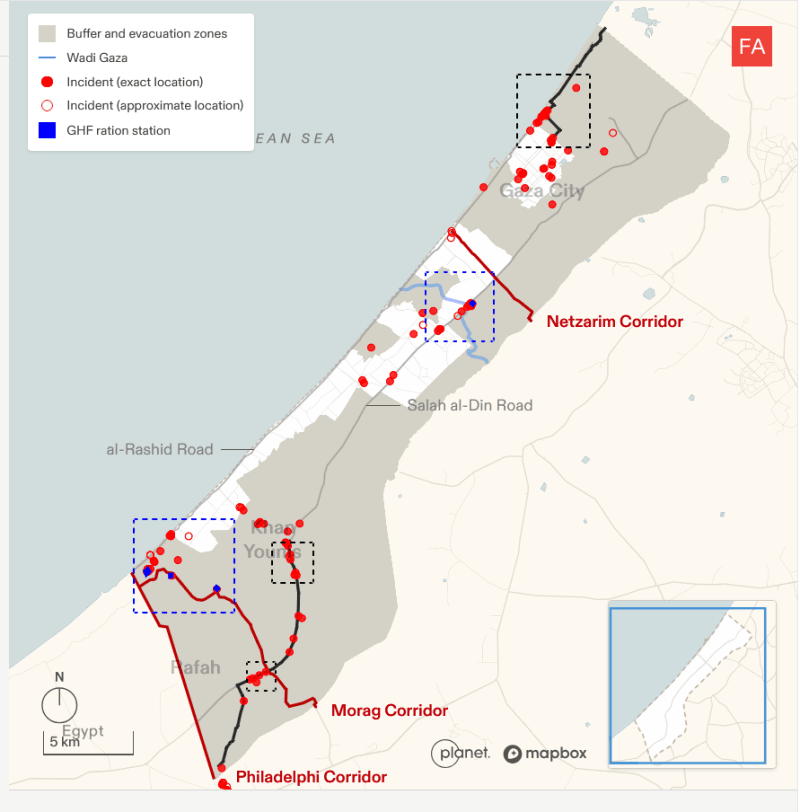
ENGLISH
FORENSIC ARCHITECTURE. REPORT 14 JULY. AID AND STARVATION AS WEAPONS
The Israeli military’s weaponisation of aid and starvation to displace and destroy Palestinian society will not stop as long as Israel controls aid distribution. Our new analysis shows how Israel has imposed a deadly aid system through GHF ration stations, while dismantling a proven civilian-led model, in order to concentrate Palestinians in Rafah and push Gazan society toward collapse.
The genocide can continue even under a ceasefire.
See the full report here.
21 July 2025 Al Jazeera
What is the ‘kill zone’ people in Gaza need to cross to receive aid?
Hundreds of starving, aid-seeking Palestinians in Gaza have lost their lives to Israeli aggression or starvation.
Palestinians transport victims to a Red Cross clinic in Rafah
By Al Jazeera Staff
Published On 21 Jul 202521 Jul 2025
People of Gaza are starving, and one of the only ways they can get any food is to risk death by going to an aid distribution point run by the notorious Israel- and United States-backed Gaza Humanitarian Foundation (GHF).Al Jazeera’s Sanad agency has analysed satellite imagery of the GHF aid distribution centre in the Shakoush area of Rafah, taken on July 13.
We trace the journey of desperately hungry people waiting for hours, sometimes days, to walk a gauntlet of Israeli tanks, armoured vehicles, and drones where they risk being shot by Israeli soldiers.Here is what they have to go through:
How do people get into the centre?...
ESPAÑOL
INFORME 14 JULIO 2025. AYUDA Y HAMBRE COMO ARMAS. FORENSIC ARCHITECTURE
El uso de la ayuda y el hambre como arma por parte del ejército israelí para desplazar y destruir la sociedad palestina no cesará mientras Israel controle la distribución de la ayuda.Nuestro nuevo análisis muestra cómo Israel ha impuesto un sistema de ayuda letal a través de los puestos de racionamiento de la GHF, al tiempo que desmantela un modelo civil de eficacia probada, para concentrar a los palestinos en Rafah y llevar a la sociedad gazatí al colapso.El genocidio puede continuar incluso con un alto el fuego.El informe completo, aquí21 julio 2025 Al Jazeera¿Cuál es la «zona mortal» que los habitantes de Gaza deben cruzar para recibir ayuda?
Cientos de palestinos hambrientos y en busca de ayuda en Gaza han perdido la vida por la agresión israelí o por inanición.
Palestinos transportan víctimas a una clínica de la Cruz Roja en Rafah
Por el personal de Al Jazeera
Publicado el 21 Jul 202521 Jul 2025
Los habitantes de Gaza se mueren de hambre y una de las únicas formas de conseguir algo de comida es arriesgarse a morir acudiendo a un punto de distribución de ayuda gestionado por la tristemente célebre Fundación Humanitaria de Gaza (GHF, por sus siglas en inglés), respaldada por Israel y Estados Unidos.La agencia Sanad de Al Jazeera ha analizado imágenes por satélite del centro de distribución de ayuda de la GHF en la zona de Shakoush, en Rafah, tomadas el 13 de julio.
Seguimos el recorrido de personas desesperadamente hambrientas que esperan durante horas, a veces días, para atravesar un guantelete de tanques, vehículos blindados y drones israelíes donde corren el riesgo de ser tiroteados por soldados israelíes.Esto es lo que tienen que pasar:
¿Cómo entra la gente en el centro?...
Israel. Inhumanas condiciones en prisión de rehenes personal sanitario palestino. الأسرى من الطواقم الطبية في معتقلات الاحتلال يعيشون ظروف مأساوية وصعبة . Prisoned medical personnel in Israeli detention centers ESP ENGLISH اَلْعَرَبِيَّة

 Ministerio de Salud Palestina - Gaza
Ministerio de Salud Palestina - Gaza 
Comunicado de Prensa Los prisioneros del personal médico en los centros de detención de la ocupación viven en condiciones trágicas y difíciles.
Los prisioneros del personal médico en los centros de detención de la ocupación viven en condiciones trágicas y difíciles. La ocupación israelí impone severas restricciones a los prisioneros en general, y especialmente a aquellos del personal médico.
La ocupación israelí impone severas restricciones a los prisioneros en general, y especialmente a aquellos del personal médico. La abogada del prisionero Dr. Hossam Abu Safiya describe el grave estado de salud del doctor y la privación deliberada de tratamiento médico.
La abogada del prisionero Dr. Hossam Abu Safiya describe el grave estado de salud del doctor y la privación deliberada de tratamiento médico. Según su última visita, la abogada del Dr. Abu Safiya describe la brutalidad a la que está siendo sometido durante los interrogatorios, incluyendo golpes continuos.
Según su última visita, la abogada del Dr. Abu Safiya describe la brutalidad a la que está siendo sometido durante los interrogatorios, incluyendo golpes continuos. El Dr. Abu Safiya, detenido desde el 27 de diciembre del año pasado, ha perdido 40 kg de peso y sufre de hipertensión y debilitamiento del músculo cardíaco.
El Dr. Abu Safiya, detenido desde el 27 de diciembre del año pasado, ha perdido 40 kg de peso y sufre de hipertensión y debilitamiento del músculo cardíaco. 360 miembros del personal sanitario han sido arrestados desde el inicio de la guerra de exterminio en la Franja de Gaza.
360 miembros del personal sanitario han sido arrestados desde el inicio de la guerra de exterminio en la Franja de Gaza. Entre los detenidos hay médicos con experiencia y especialidades médicas vitales, de las que han sido privados los pacientes y heridos.
Entre los detenidos hay médicos con experiencia y especialidades médicas vitales, de las que han sido privados los pacientes y heridos. El Ministerio de Salud exige a las partes competentes que intervengan de manera urgente para criminalizar las prácticas de la ocupación contra el personal médico prisionero y presionar para su liberación.
El Ministerio de Salud exige a las partes competentes que intervengan de manera urgente para criminalizar las prácticas de la ocupación contra el personal médico prisionero y presionar para su liberación.
Ministerio de Salud
14 de julio de 2025ENGLISH
*Palestinian Ministry of Health - Gaza*
*Press Release*14 July 2025
Prisoned medical personnel in Israeli detention centers are experiencing tragic and difficult conditions.
The Israeli occupation imposes severe restrictions on prisoners in general and on medical personnel in particular.
The lawyer for prisoner Dr. Hussam Abu Safia describes Dr. Abu Safia's critical health condition and the deliberate denial of treatment.
Dr. Abu Safia's lawyer, based on his last visit, describes the brutality Dr. Abu Safia is subjected to during interrogation and the constant beatings he is subjected to. Dr. Abu Safia, who has been detained since December 27 of last year, has lost 40 kg and suffers from high blood pressure and a weak heart muscle.
360 medical personnel have been arrested since the beginning of the genocidal war on the Gaza Strip.
Among the detained prisoners are doctors with medical expertise and important specialties, which patients and the wounded are denied.
The Ministry of Health calls on the relevant authorities to urgently intervene to criminalize the occupation's practices against detained medical personnel and pressure them to release.
*Ministry of Health* July 14, 2025
*
 وزارة الصحة الفلسطينية-غزة
وزارة الصحة الفلسطينية-غزة  *
*
*تــصريح صحـــفي* الأسرى من الطواقم الطبية في معتقلات الاحتلال يعيشون ظروف مأساوية وصعبة .
الأسرى من الطواقم الطبية في معتقلات الاحتلال يعيشون ظروف مأساوية وصعبة . الاحتلال الإسرائيلي يفرض قيود مشدده على الأسرى بشكل عام وعلى الأسرى من الطواقم الطبية بشكل خاص .
الاحتلال الإسرائيلي يفرض قيود مشدده على الأسرى بشكل عام وعلى الأسرى من الطواقم الطبية بشكل خاص . محامية الأسير الدكتور حسام أبو صفية تصف الحالة الصحية الصعبة للدكتور أبو صفية والحرمان المتعمد من العلاج.
محامية الأسير الدكتور حسام أبو صفية تصف الحالة الصحية الصعبة للدكتور أبو صفية والحرمان المتعمد من العلاج.  محامية د.أبو صفية وفق آخر زيارة له تصف وحشية مايتعرض له د. أبو صفية خلال التحقيق وتعرضه للضرب بشكل متواصل .
محامية د.أبو صفية وفق آخر زيارة له تصف وحشية مايتعرض له د. أبو صفية خلال التحقيق وتعرضه للضرب بشكل متواصل . الدكتور أبو صفية والمعتقل منذ 27 ديسمبر العام الماضي فقد 40 كغم من وزنه ويعاني من ارتفاع ضغط الدم وضعف عضلة القلب .
الدكتور أبو صفية والمعتقل منذ 27 ديسمبر العام الماضي فقد 40 كغم من وزنه ويعاني من ارتفاع ضغط الدم وضعف عضلة القلب .
 360 من الطواقم الصحية تعرضوا للاعتقال منذ بداية حرب الابادة الجماعية على قطاع غزة .
360 من الطواقم الصحية تعرضوا للاعتقال منذ بداية حرب الابادة الجماعية على قطاع غزة . من بين الأسرى المعتقلين أطباء من ذوي الخبرة الطبية والتخصصات المهمة والتي حُرم المرضى والجرحى منها .
من بين الأسرى المعتقلين أطباء من ذوي الخبرة الطبية والتخصصات المهمة والتي حُرم المرضى والجرحى منها . وزارة الصحة تطالب الجهات المعنية بالتدخل العاجل لتجريم ممارسات الاحتلال بحق الأسرى من الطواقم الطبية والضغط للافراج عنهم .
وزارة الصحة تطالب الجهات المعنية بالتدخل العاجل لتجريم ممارسات الاحتلال بحق الأسرى من الطواقم الطبية والضغط للافراج عنهم .
*وزارة الصحة*
14 يوليو 2025ENGLISH
*Palestinian Ministry of Health - Gaza*
*Press Release*14 July 2025
Prisoned medical personnel in Israeli detention centers are experiencing tragic and difficult conditions.
The Israeli occupation imposes severe restrictions on prisoners in general and on medical personnel in particular.
The lawyer for prisoner Dr. Hussam Abu Safia describes Dr. Abu Safia's critical health condition and the deliberate denial of treatment.
Dr. Abu Safia's lawyer, based on his last visit, describes the brutality Dr. Abu Safia is subjected to during interrogation and the constant beatings he is subjected to. Dr. Abu Safia, who has been detained since December 27 of last year, has lost 40 kg and suffers from high blood pressure and a weak heart muscle.
360 medical personnel have been arrested since the beginning of the genocidal war on the Gaza Strip.
Among the detained prisoners are doctors with medical expertise and important specialties, which patients and the wounded are denied.
The Ministry of Health calls on the relevant authorities to urgently intervene to criminalize the occupation's practices against detained medical personnel and pressure them to release.
*Ministry of Health* *July 14, 2025*
The situation of older persons in Gaza June 2025. La ancianidad en Gaza
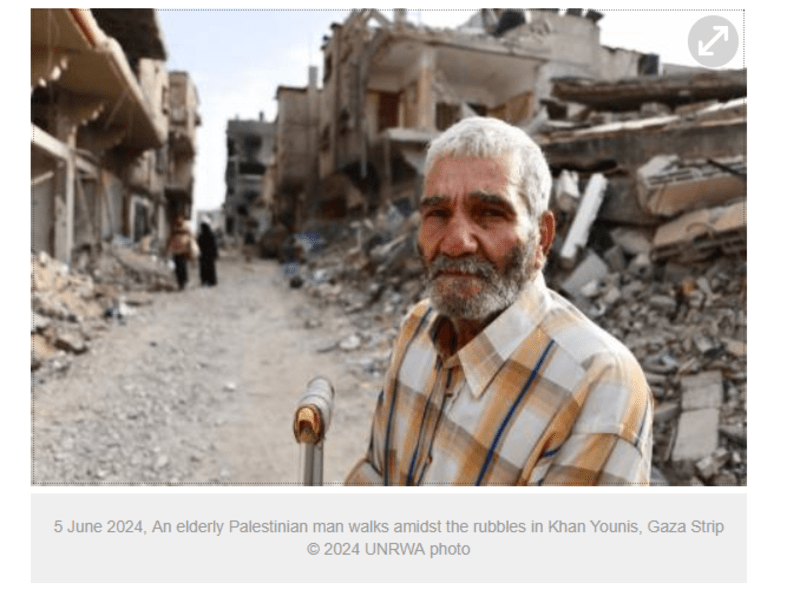
ENGLISH
The heightened risks older persons face as a result of ongoing Israel hostilities in Gaza. Protection brief. June 2025. UNRWA (The situation of older persons in Gaza)
Older people have had essential roles in Gaza— leading communities, caring for relatives, and helping sustain collective memory.
Limited mobility, chronic health conditions, and the collapse of health and support systems on which they previously depended all contribute to their vulnerability during the genocide, while frequent forced displacement, chronic shortages of food and clean water, and overcrowded and unhygienic living conditions further exacerbate the risks they face.
The sheer scale of the genocide in Gaza has often masked their specific vulnerabilities and needs. Only a permanent ceasefire and unhindered humanitarian access can improve protection for civilians in Gaza, including older persons.
"We have lived through humiliation in all its forms"...a displaced elderly man in Deir Al-Balah
ESPAÑOL
Los mayores riesgos que enfrentan las personas mayores como resultado de las hostilidades de Israel en curso en Gaza.
Las personas mayores han desempeñado papeles esenciales en Gaza: liderar comunidades, cuidar de sus familiares y contribuir a la preservación de la memoria colectiva.
La movilidad limitada, las enfermedades crónicas y el colapso de los sistemas de salud y apoyo de los que anteriormente dependían contribuyen a su vulnerabilidad durante el genocidio, mientras que los frecuentes desplazamientos forzados, la escasez crónica de alimentos y agua potable, y las condiciones de vida de hacinamiento e insalubridad agravan aún más los riesgos que enfrentan.
La magnitud de la crisis en Gaza a menudo ha enmascarado sus vulnerabilidades y necesidades específicas. Solo un alto el fuego permanente y un acceso humanitario sin trabas pueden mejorar la protección de la población civil en Gaza, incluidas las personas mayores.
"Hemos vivido todas las formas de humillación"...un anciano desplazado en Deir Al-Balah.



